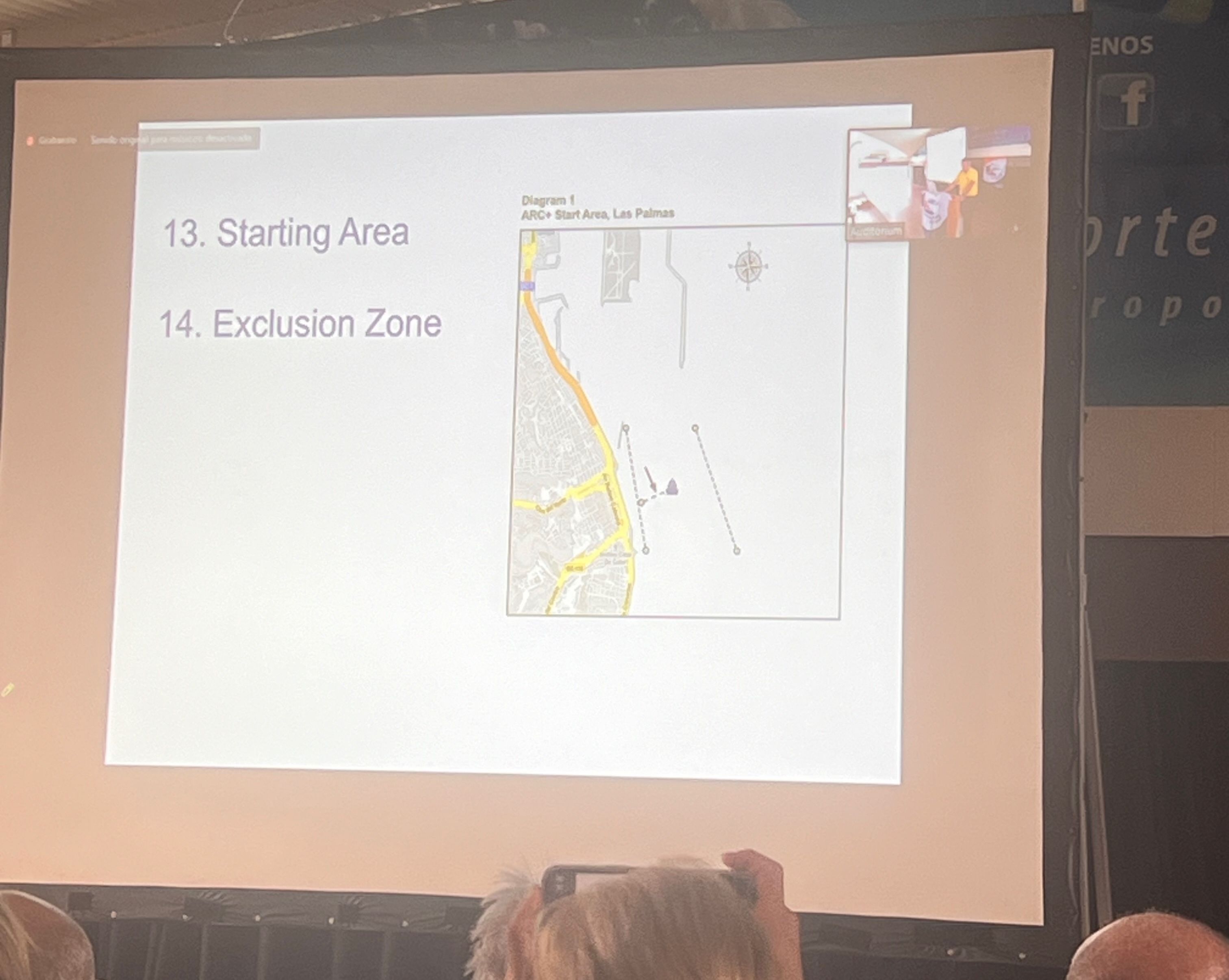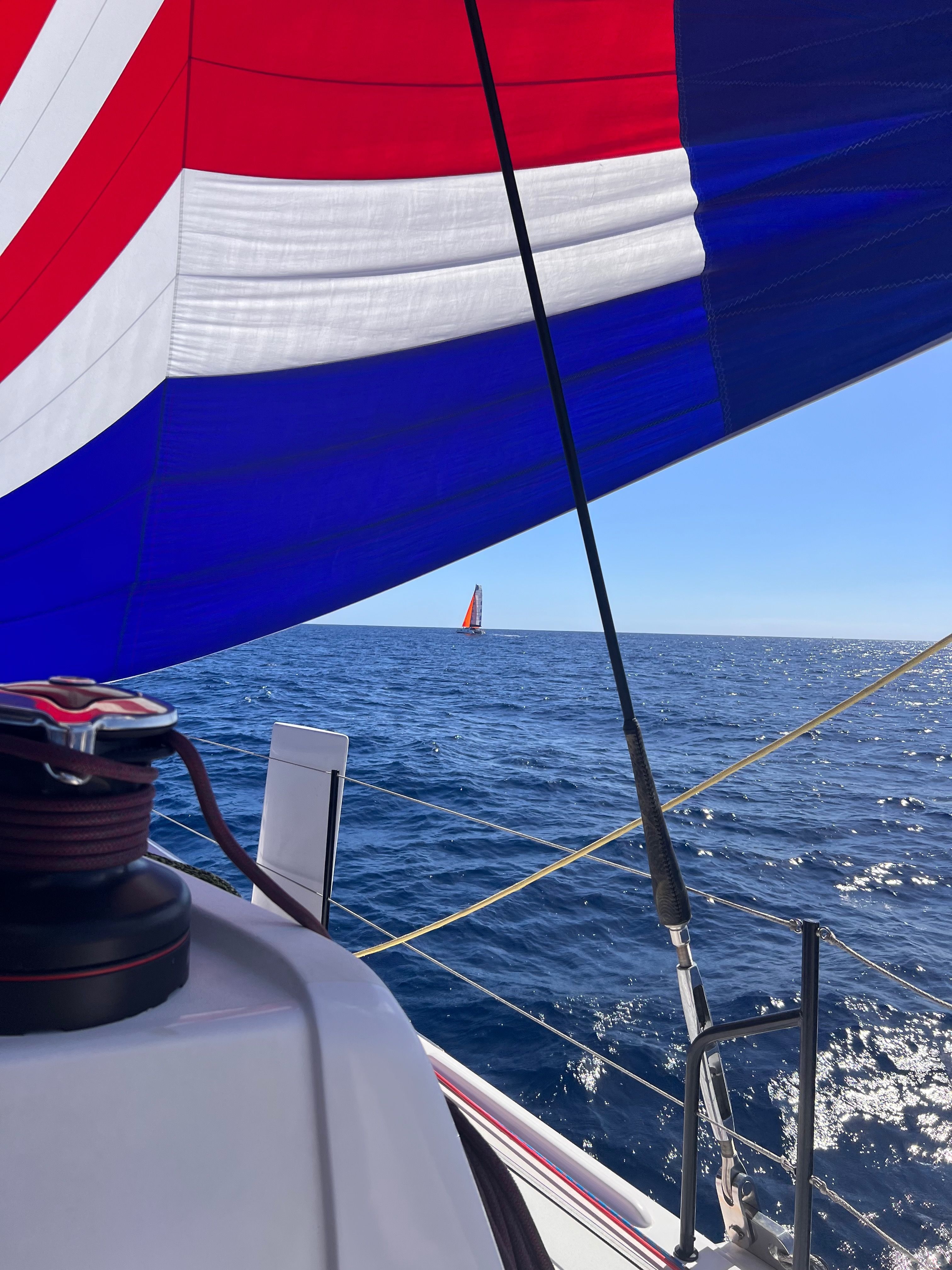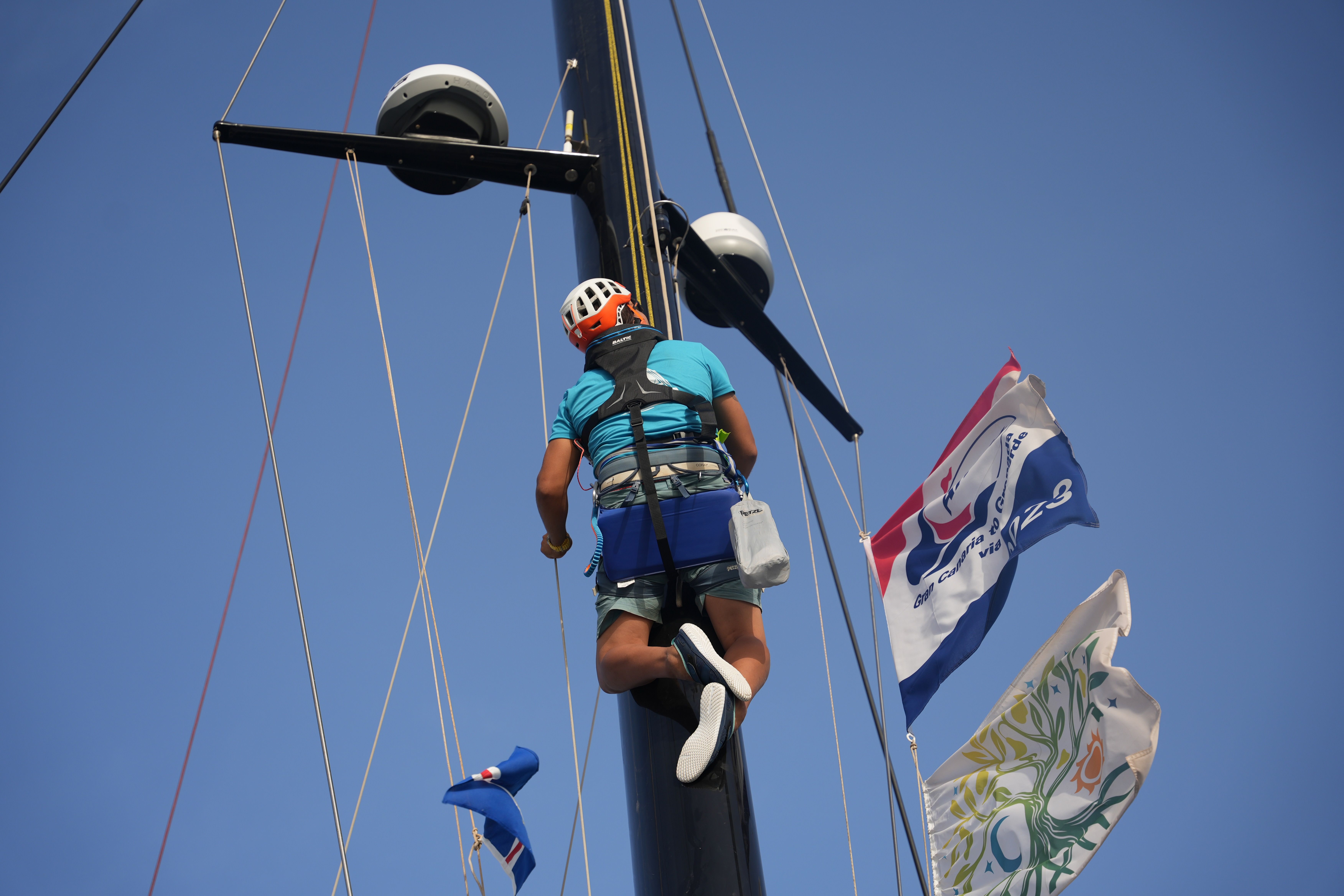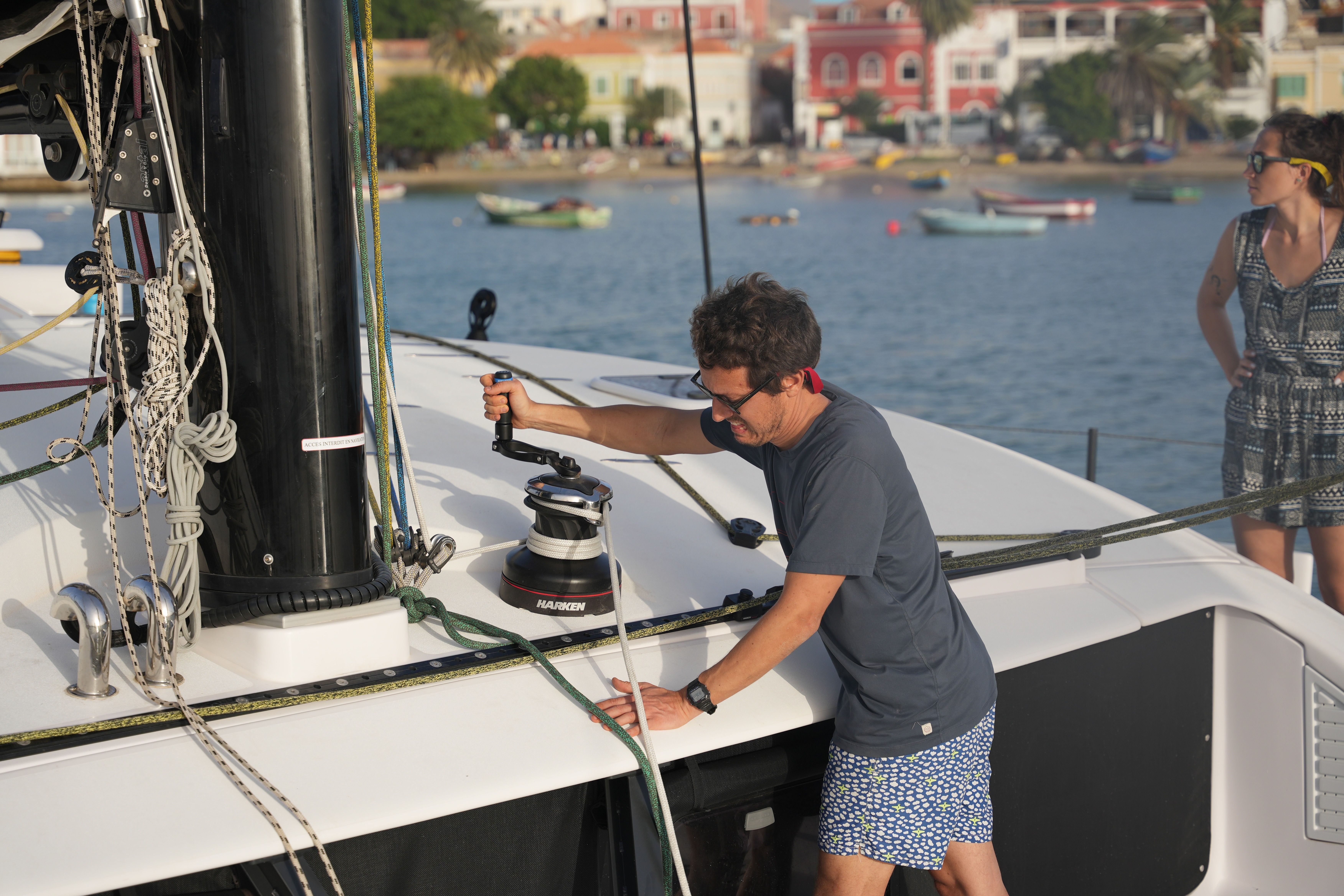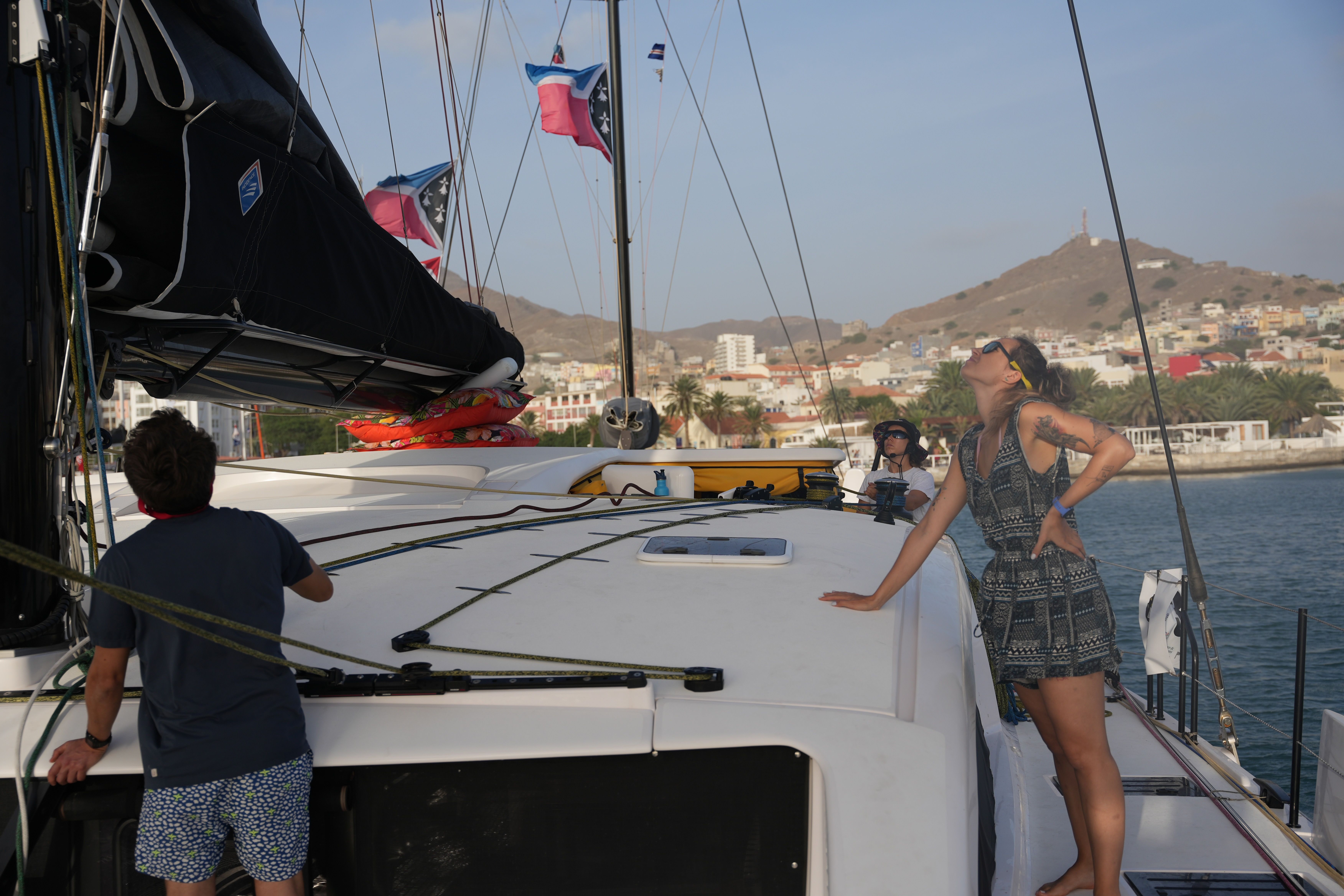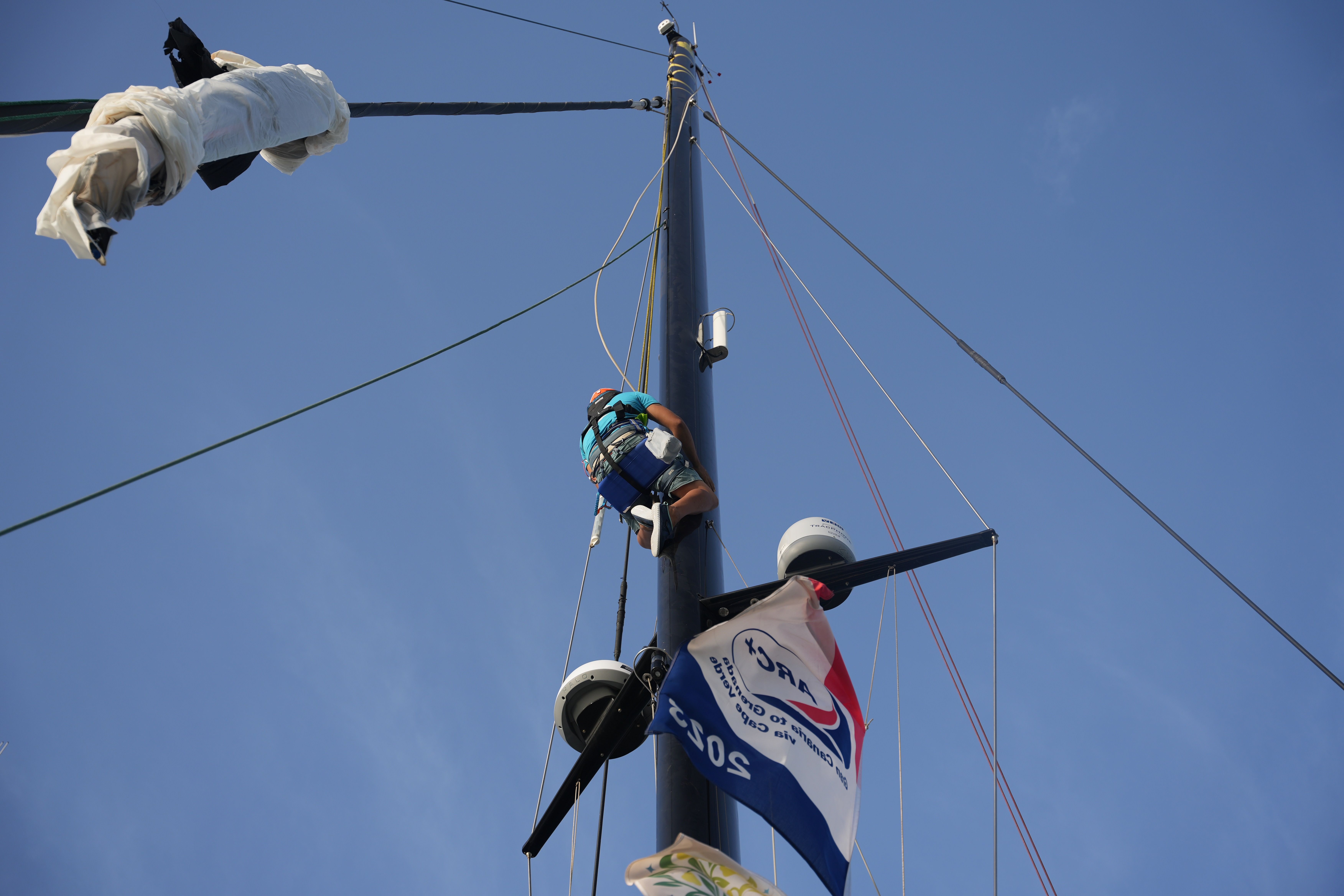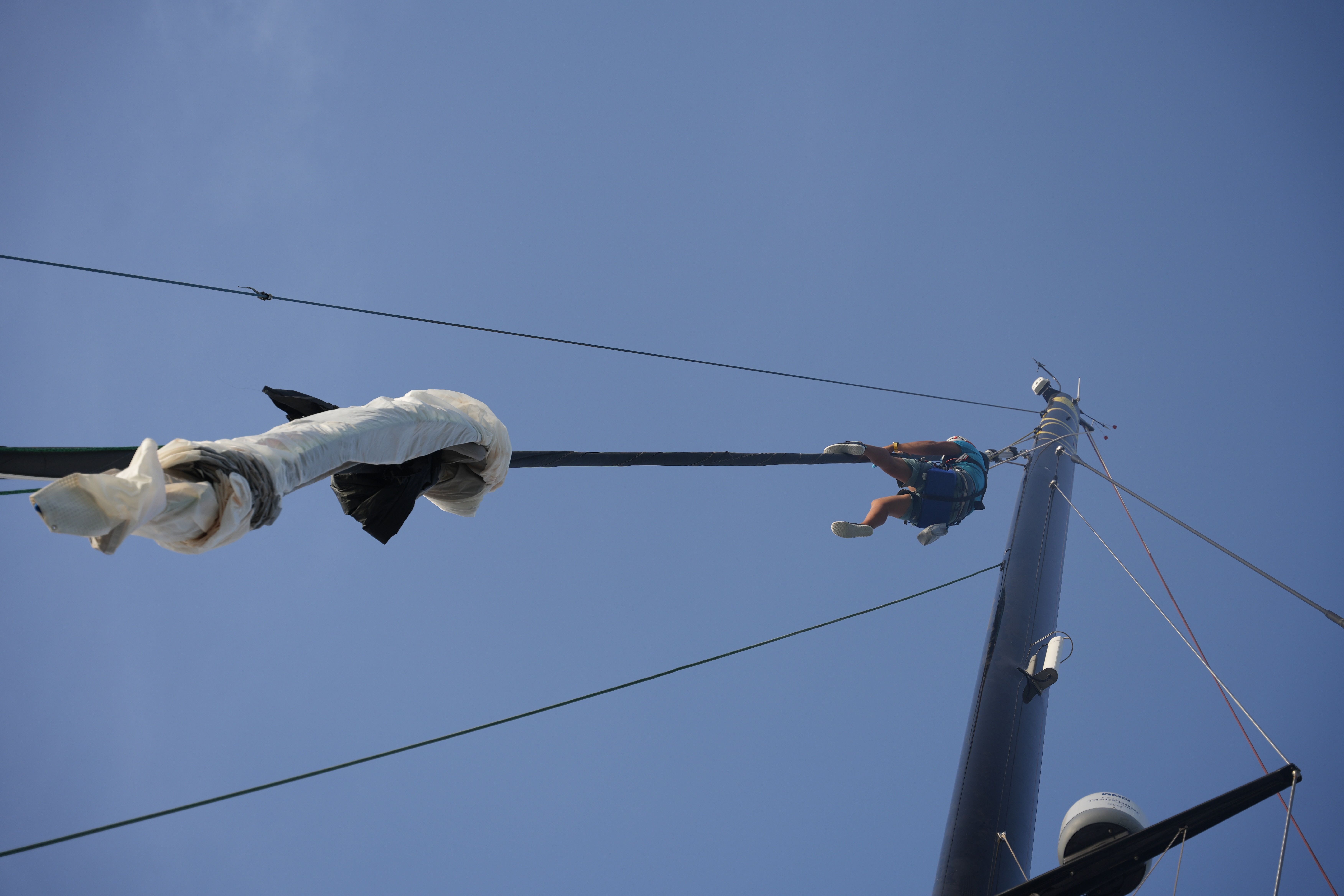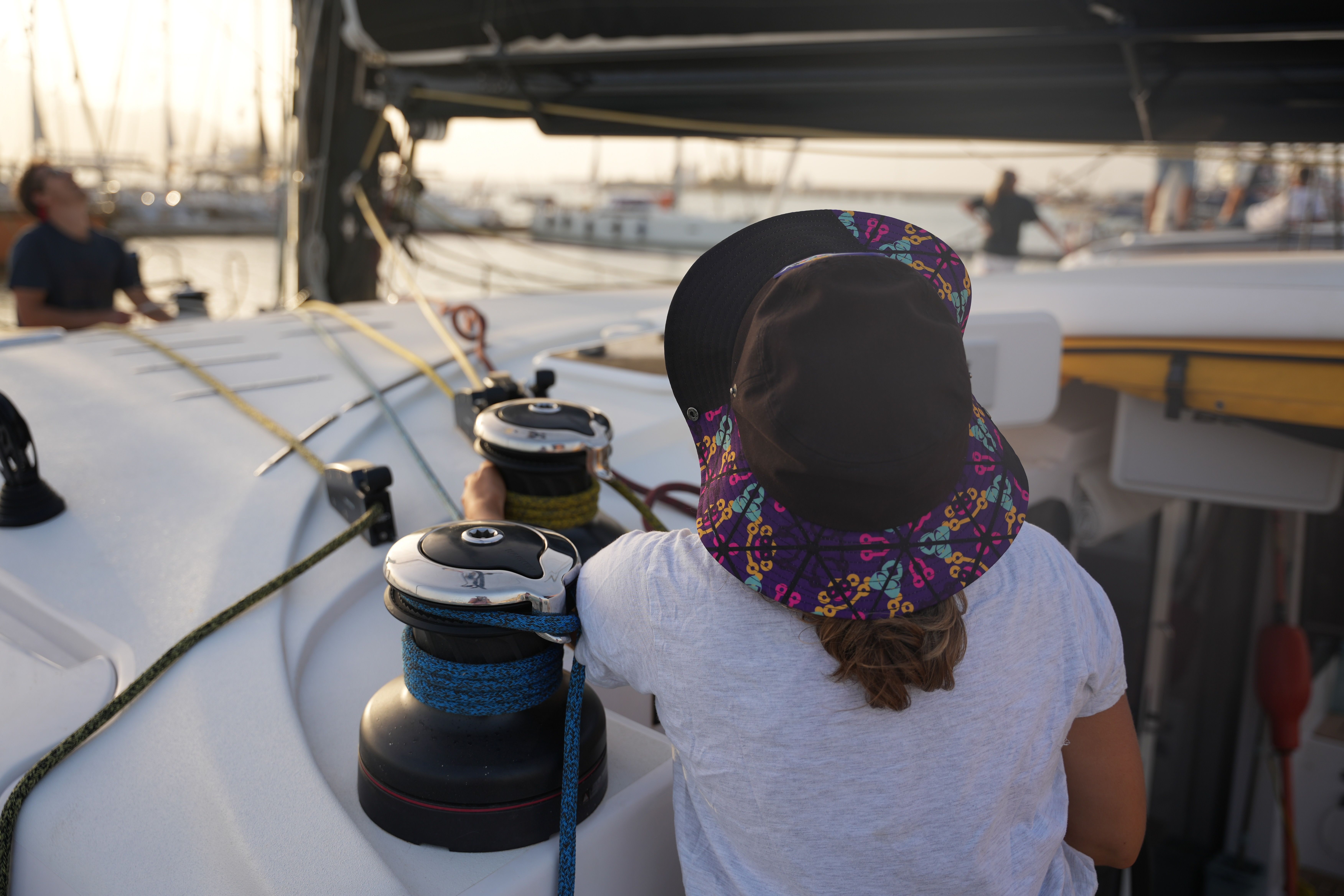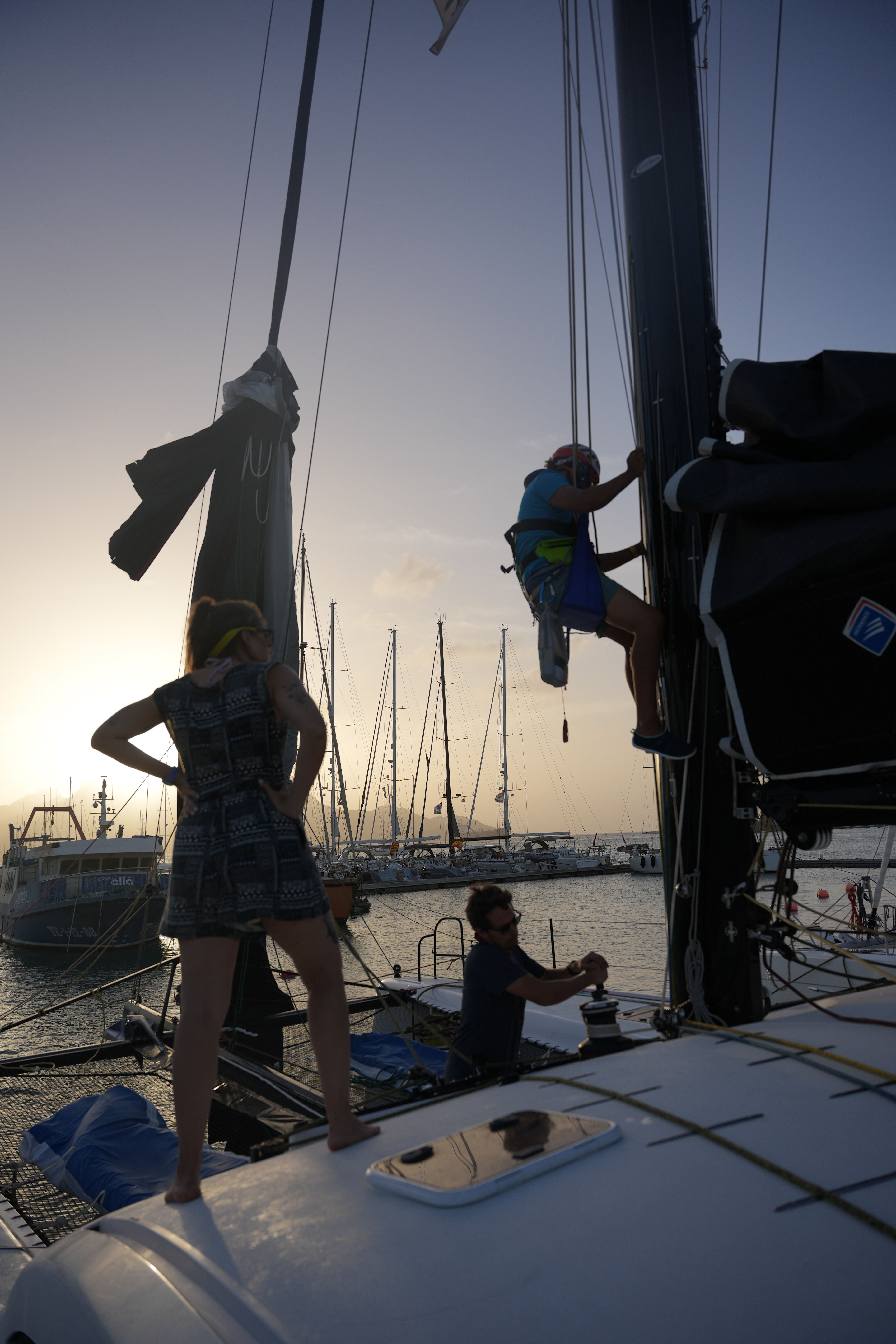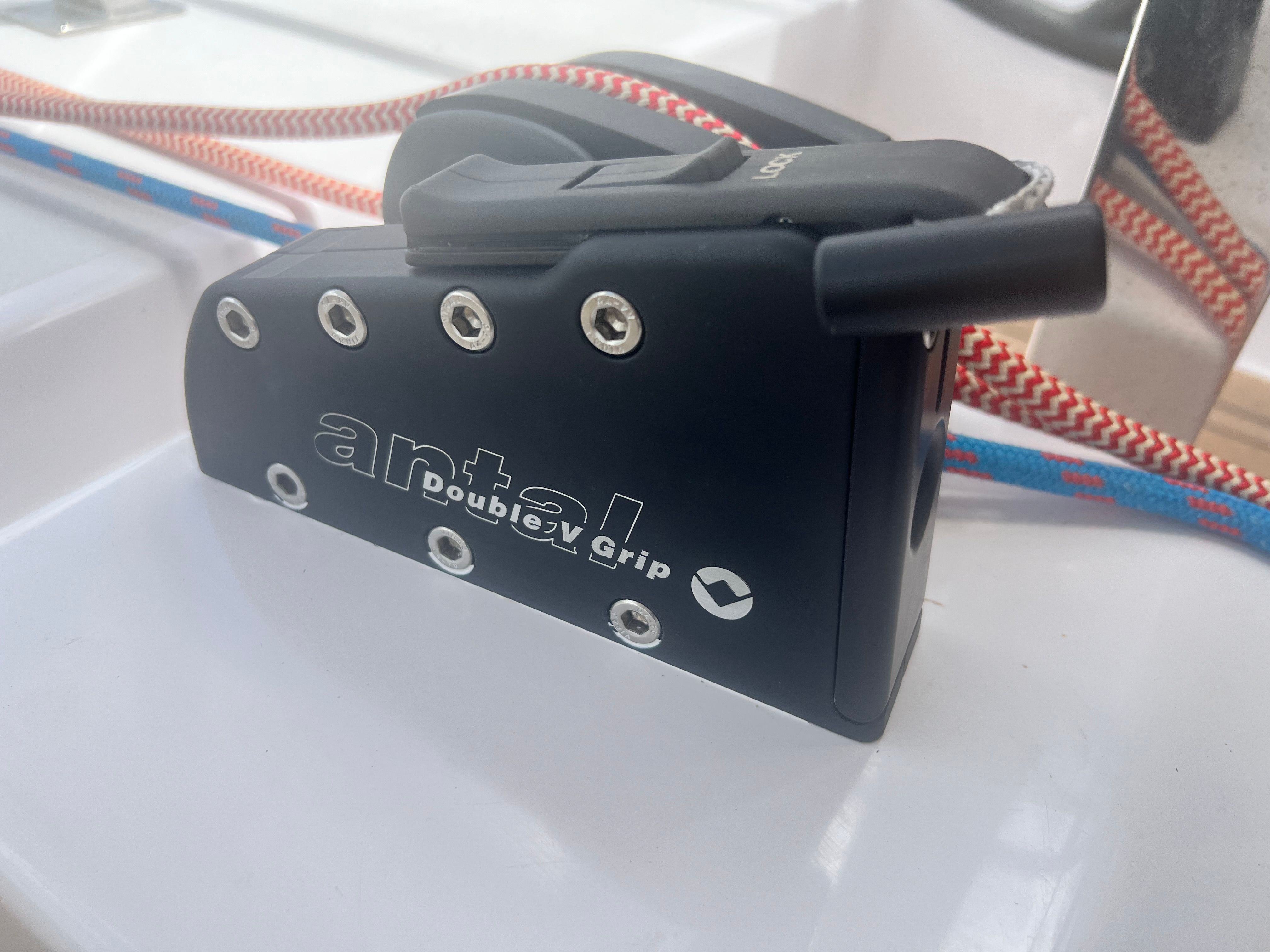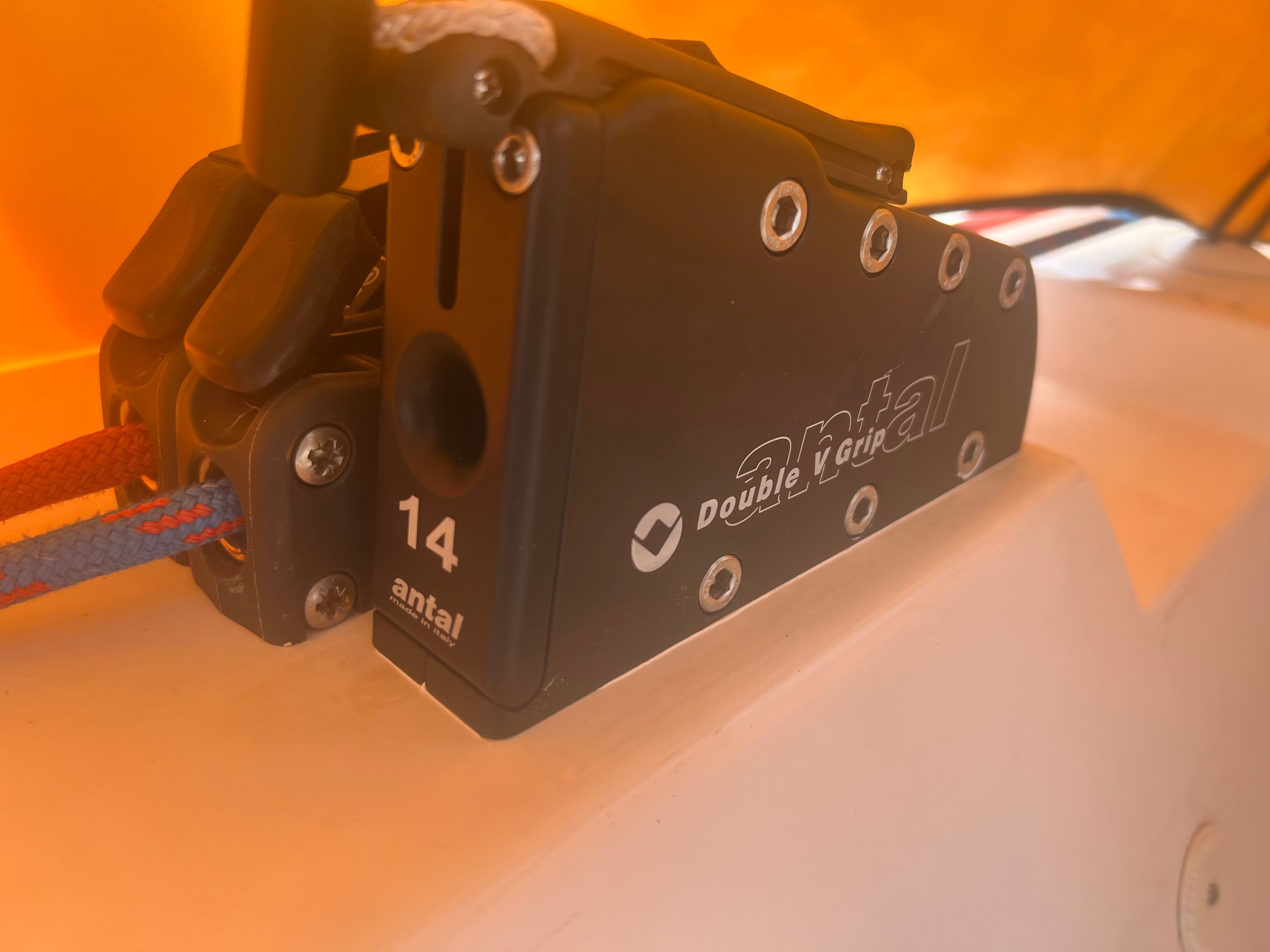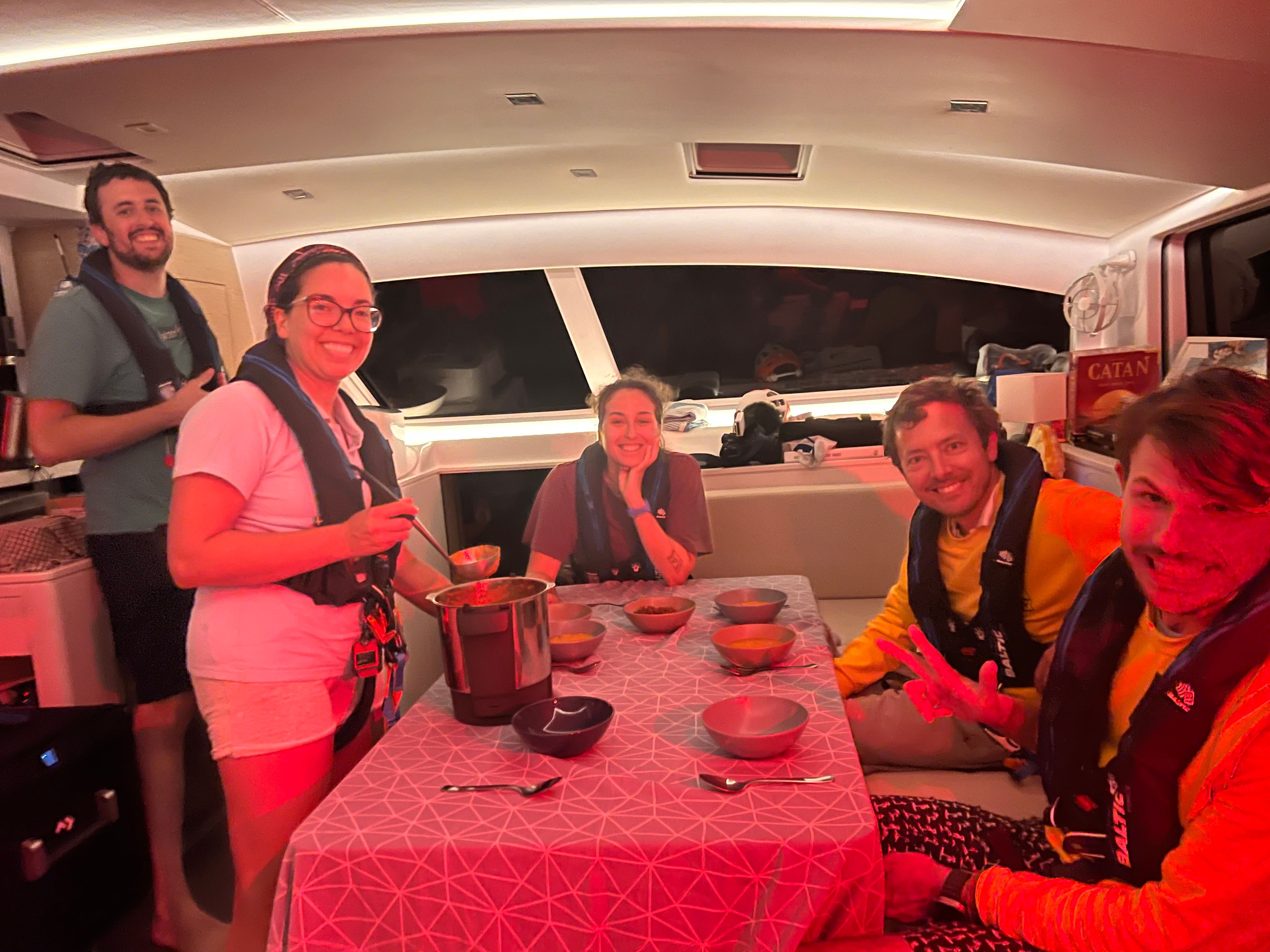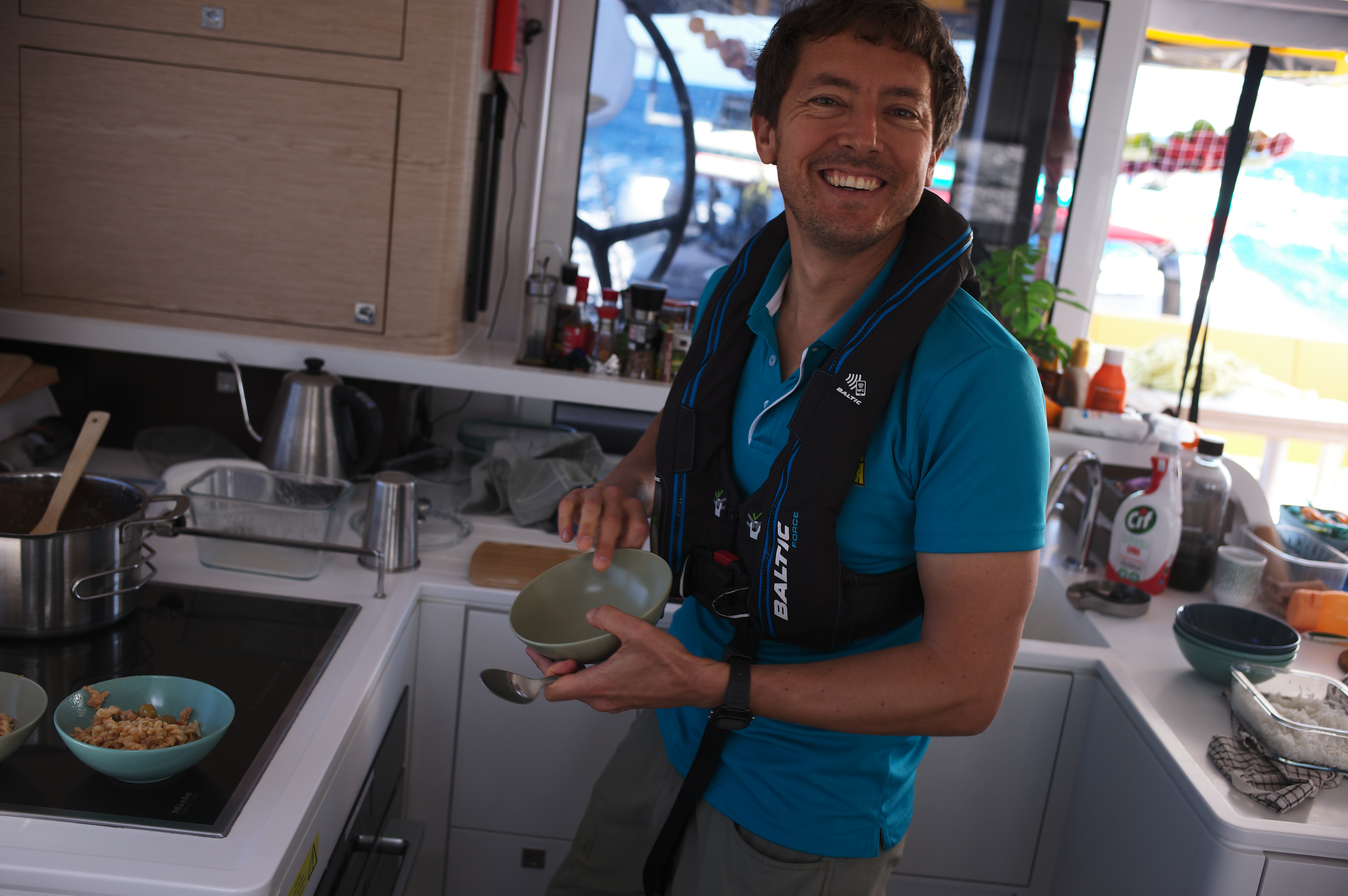Ahoy sailor ☀️
There we were. Unbelievable. It was the morning of November 5th 2023, it was departure day, and we were ready!
🤩 An incredible, exhilarating, formidable start!#
Las Palmas was buzzing. As everyone got ready, we oscillated between nervousness and excitement. We were finally going through our departure checklist, discussing the manoeuver to exit our spot at the marina, putting our swag on… smiles, smiles, smiles!
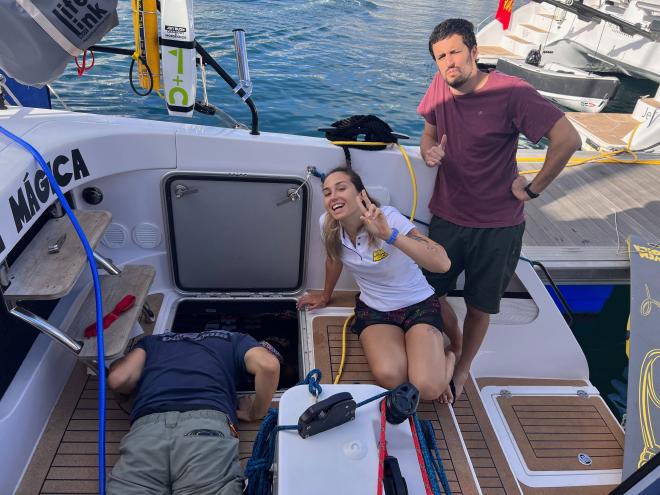
We were on a schedule. Along with the weather briefing by Chris Tibbs, we received very precise instructions about how to proceed to the starting area and what to look out for:
1235 UTC: Warning signal (‘M’ flag hoisted, 1 sound signal)1240 UTC: Preparatory signal (‘P’ flag hoisted, 1 sound signal)1245 UTC: Starting signal (Both flags lowered, 1 long sound signal, a maroon may also be fired)
We were keeping our eyes peeled for the committee vessel and staying clear of the exclusion zone.
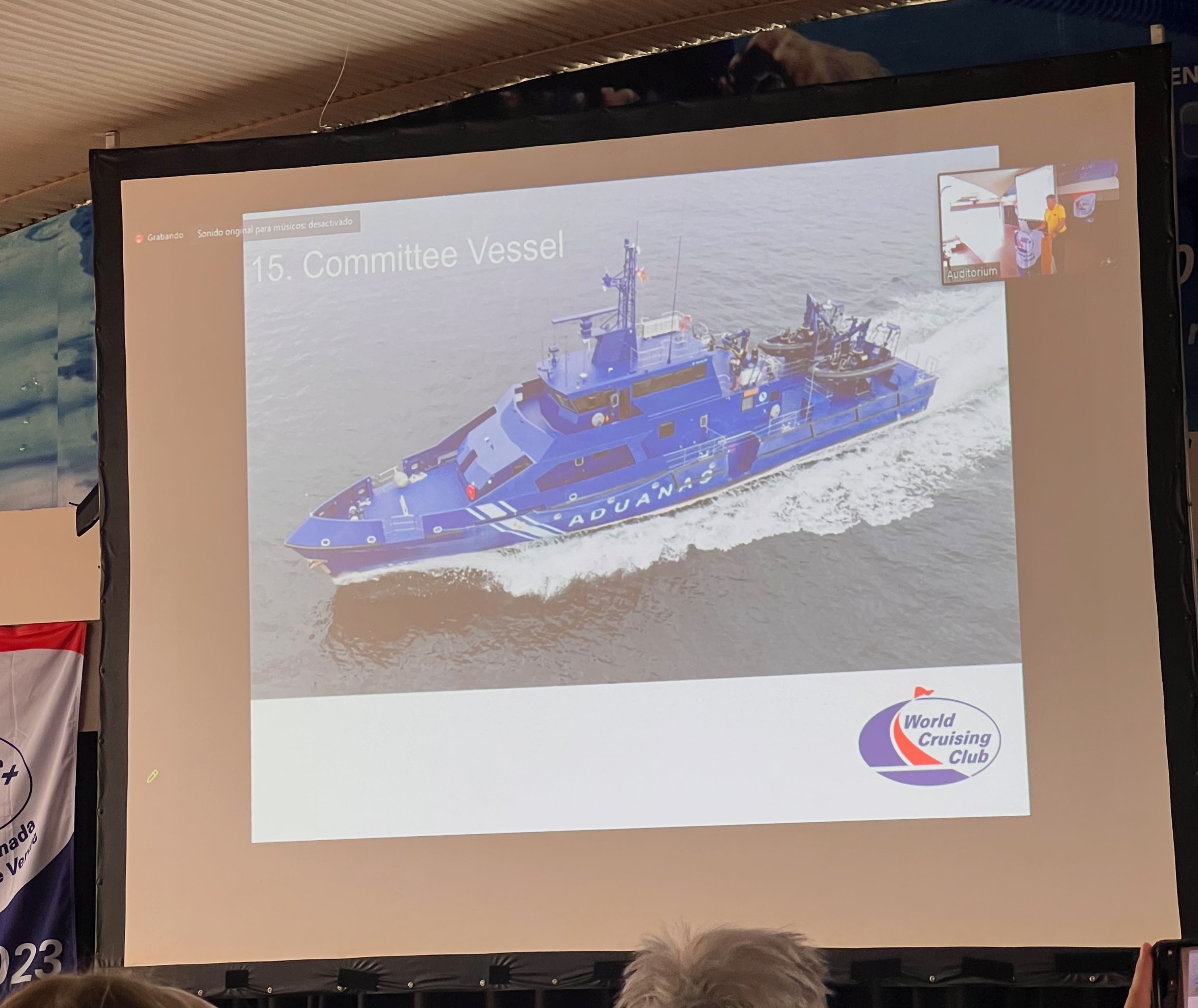
What followed was an almost magically coordinated dance. Imagine: over 90 boats within or just outside Las Palmas port, raising the main sails and readying their headsails. As the starting time neared, it was time to open the gennakers, jibs, genoas… and when the starting signal was sounded, a stream of sailing vessels passed through the starting line, officially marking the beginning of their Atlantic Crossing!


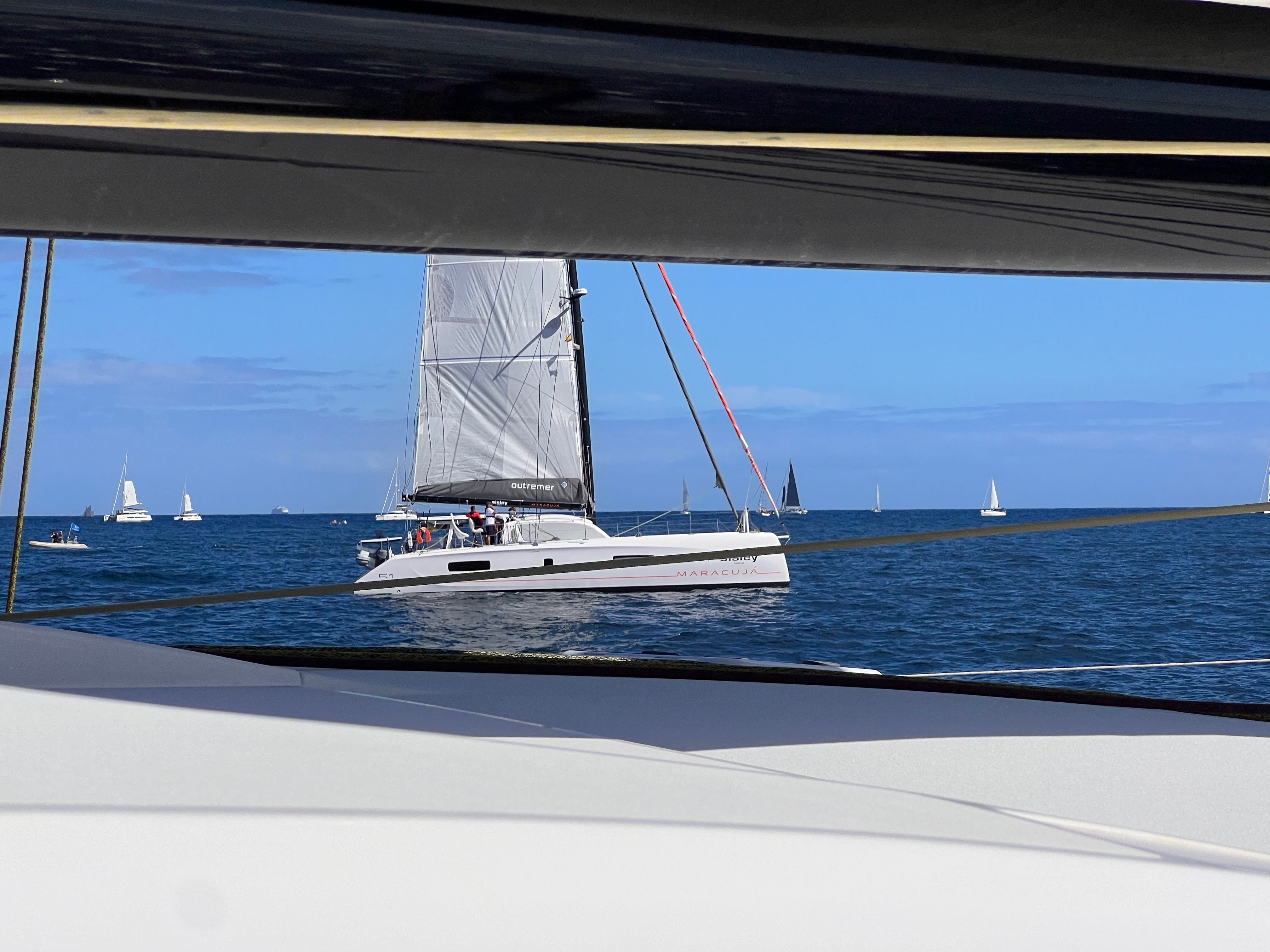
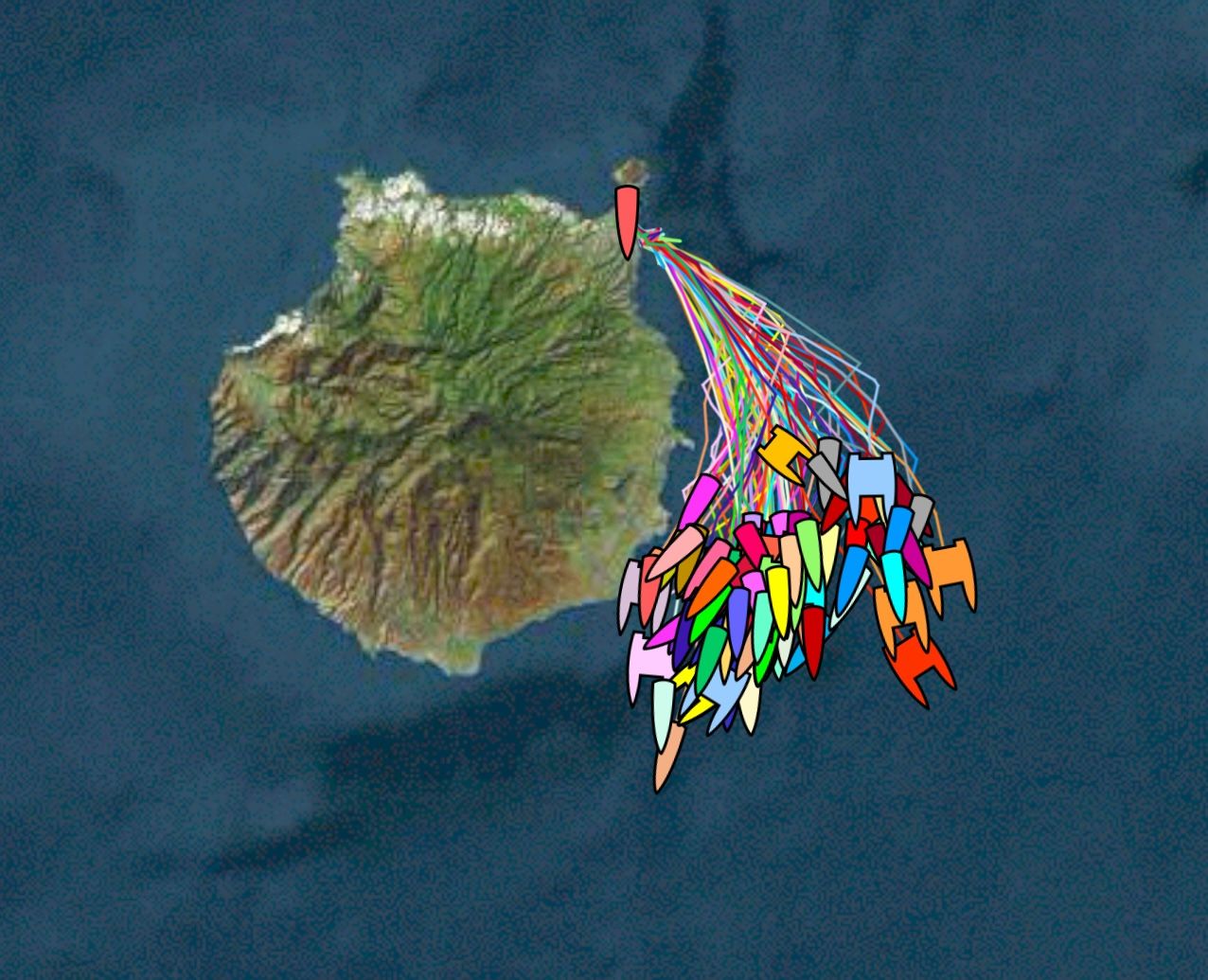
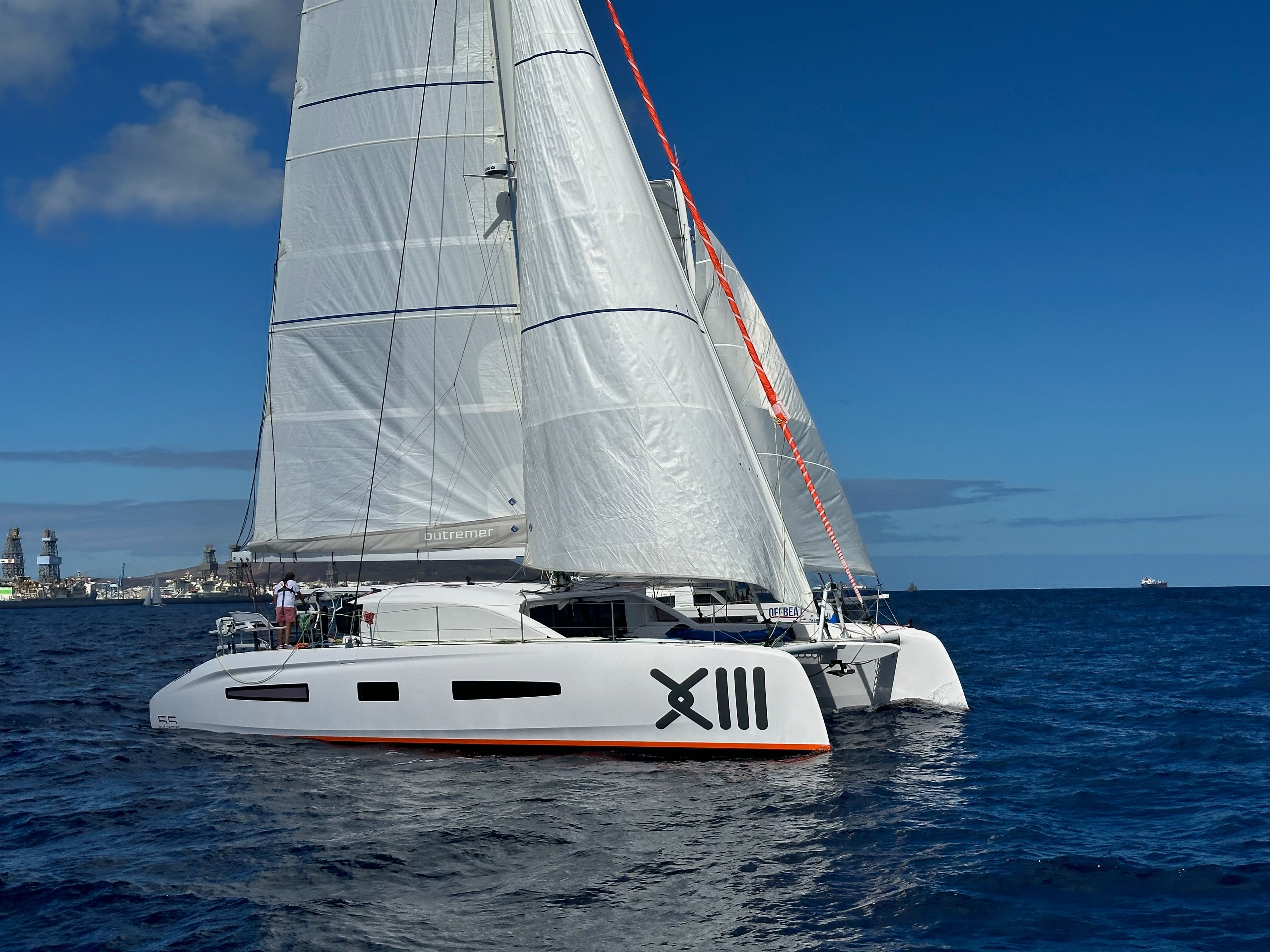
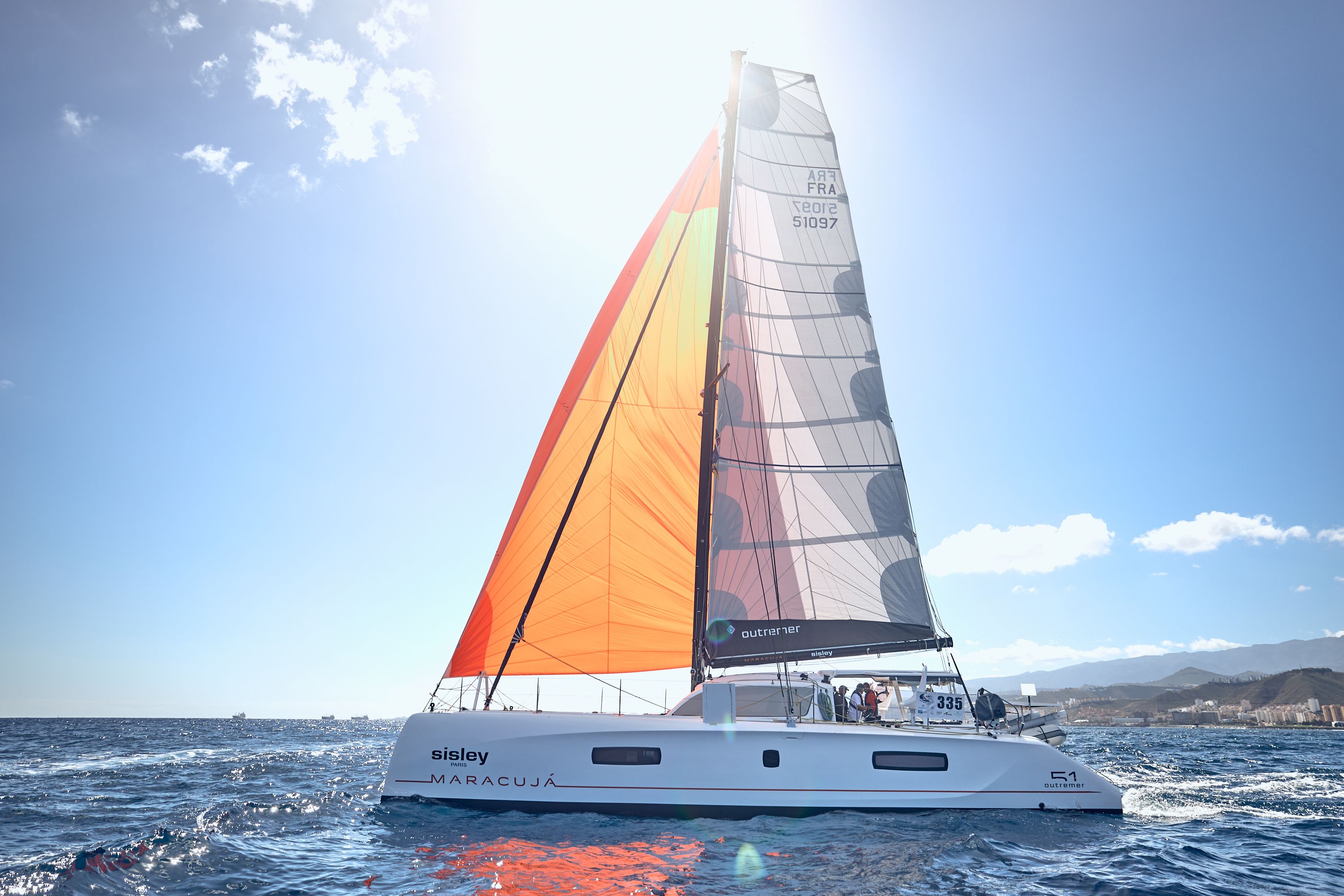

⏱️ The first 24 hours#
The first day and night at sea were incredible. We sailed really well, the crew was positively beaming, we ate the lasagna with boat-made bechamel sauce Inês had prepared, the night was smooth…
We envisioned a crossing similar in spirit to our Gibraltar to Canary Islands passage.
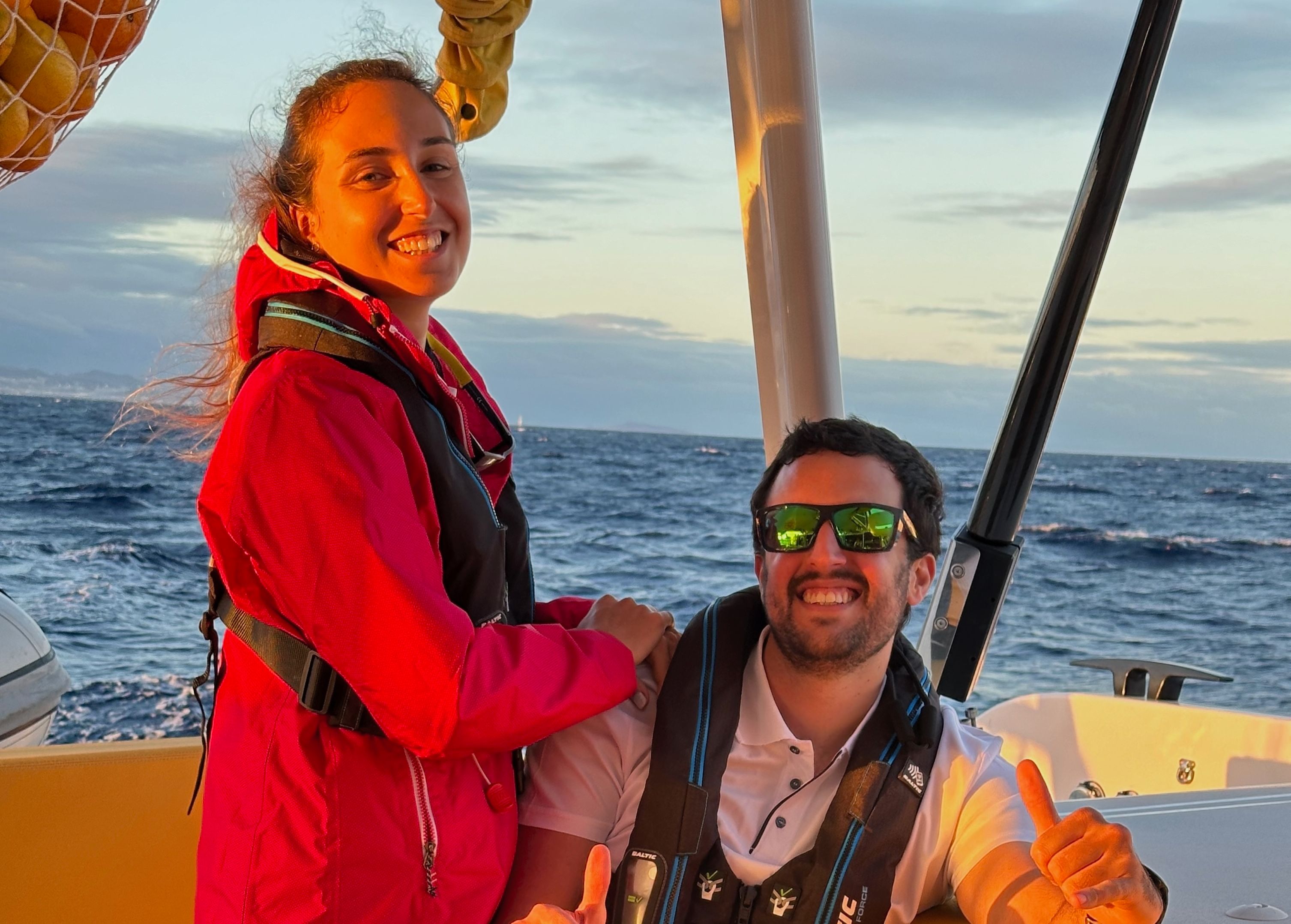
😬 And then…#
On the morning of November 6th, the real adventure started. As predicted, the wind was picking up and we wanted to hoist our brand new symmetrical spinnaker. It was the perfect sail, designed for heavy weather, capable of dealing with gusts up to 35 knots, smaller, thick and perfect for the angle where the wind was coming from.
We got it ready, and asked the crew to record what we believed was going to be a magical moment. Little did we know what was about to come next. So, what happened? Well… where should we start?
🪭 The Tale of the Symmetric Spinnacker#
In waves that rose, two meters tall,
We set our course, prepared to brawl.
From Canary Isles to Mindelo’s shore,
A tale of struggle, or something more?
Amidst the waves, excitement filled the air,
Sailing that first night… the dreams we shared!
Smiles on each face, eyes with glee,
Adventure beckoning on the endless sea.
Good food, good company, spirits soaring high,
What a first night at sea beneath the moonlit sky!
On the second day, waves 3 meters high,
We decided it was time for the spinnaker to fly.
But, once hoisted, its dance was brief,
Chaos reigned aboard, and so did disbelief.
Jammers let slip, lines came dashing,
Spinnaker’s fury, our hopes thrashing.
Spinnaker wrapping the forestay,
Tighter and tighter, to our dismay.
Three times aloft, David braved the mast,
To tame the sail that threatened fast.
Wrapped head, wrapped tack, a fierce middle bubble,
Even sailing downwind, our rigging’s trouble.
With makeshift rigging, all halyards set,
We sailed on, worried, beset.
In confused waves, 4 days we surfed along,
With gusts at 35, and waves strong.
No heroes here, just souls at sea,
Facing our fears, searching for lee.
Mauritania, we considered. What if we dismasted?
I will not lie, we were sometimes gasted.
Plans of backup, plan A, B and C.
What would we do if this scenario came to be?
But the crew was strong, calm and serene,
Inês and David were grateful to the team.
After 5 days and 4 nights, surfing waves,
Nuvem Mágica arrived, she was saved.
In Mindelo she glided, one sunny morning,
Still reefed, no headsail adorning.
Relief as land drew near,
Grins and cheers, dispelling fear.
Safe harbor found, the arrival was nigh,
And Nuvem Mágica’s crew breathed a contented sigh.
😓 It was tough#

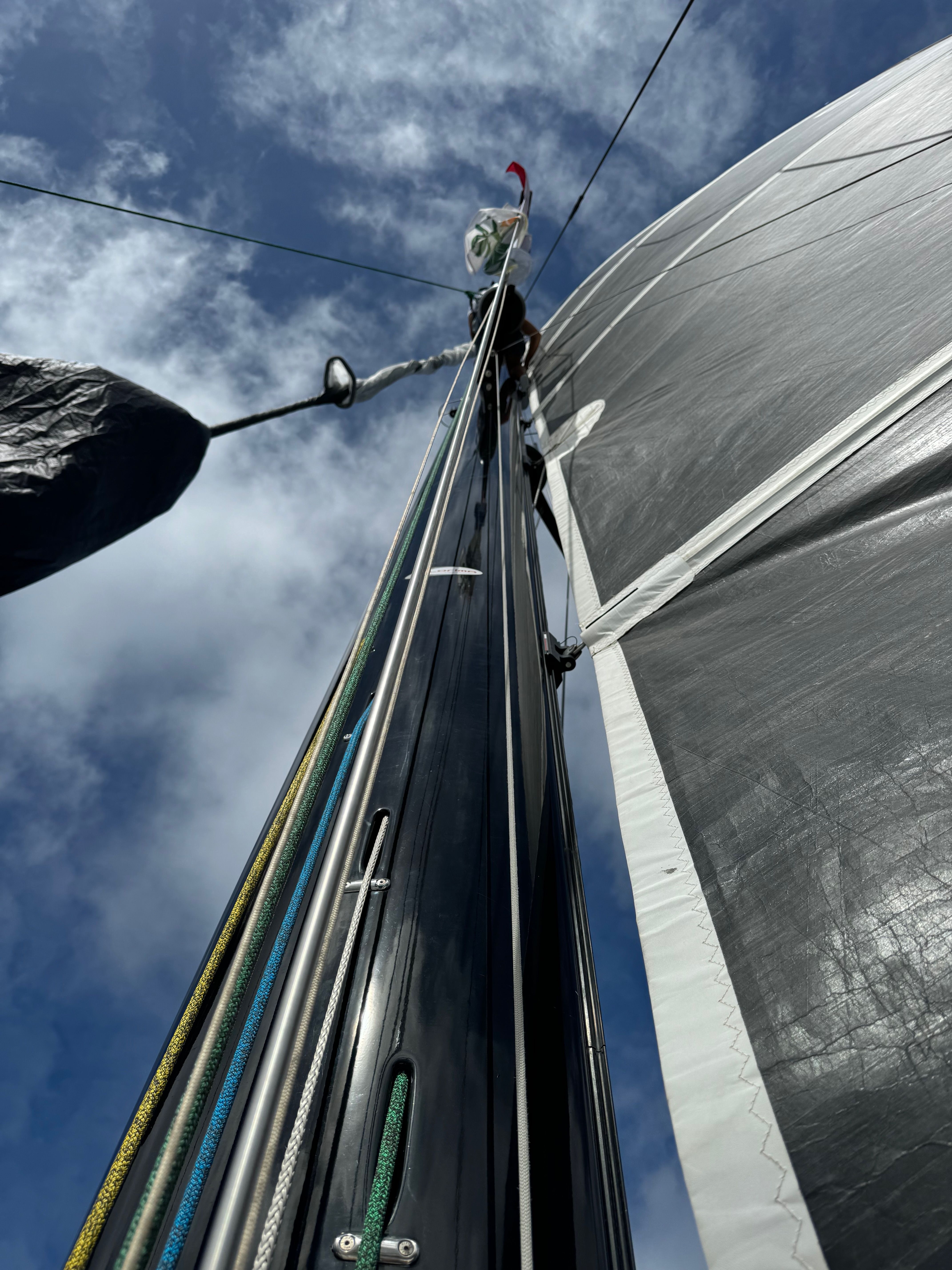
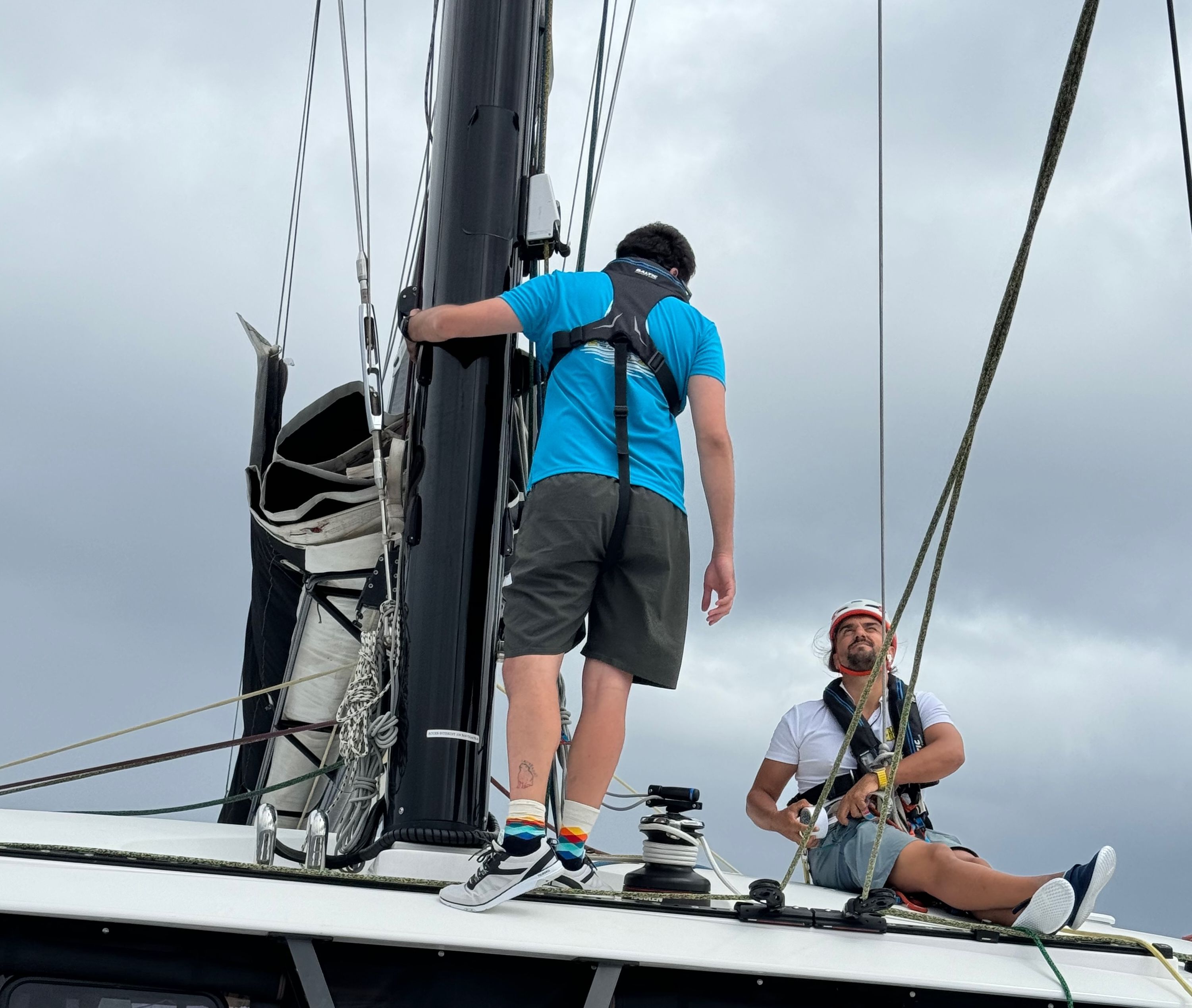
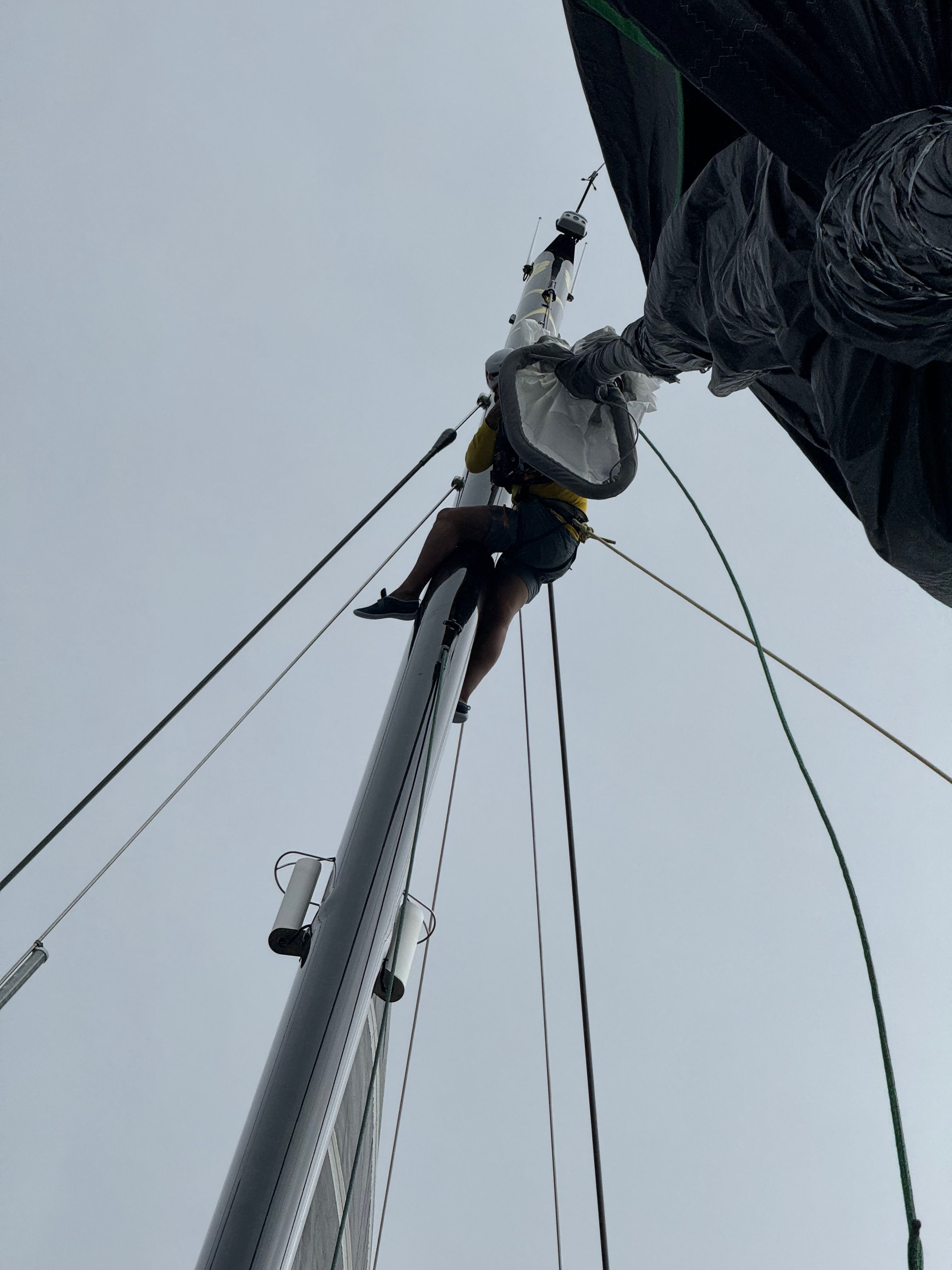
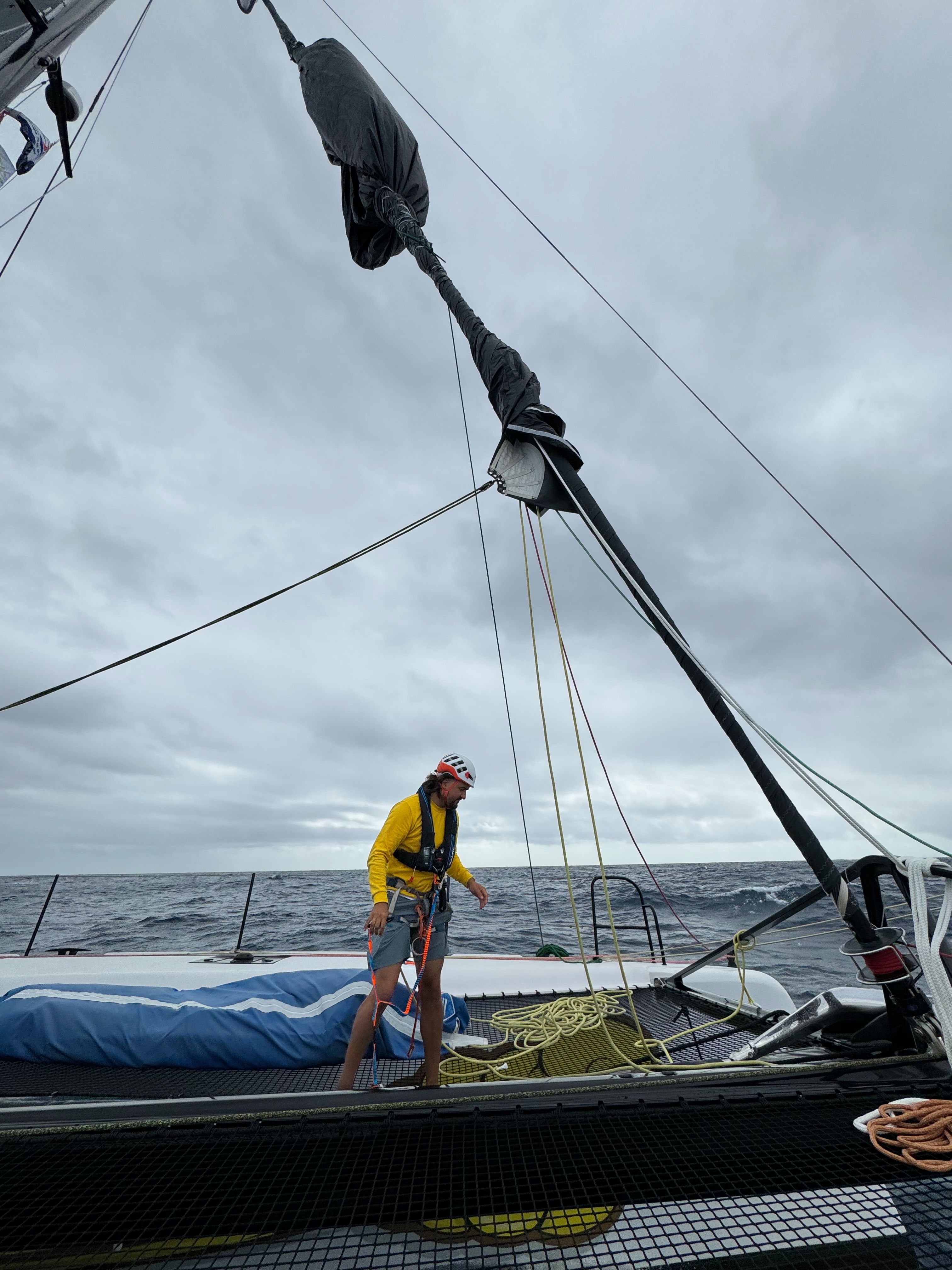
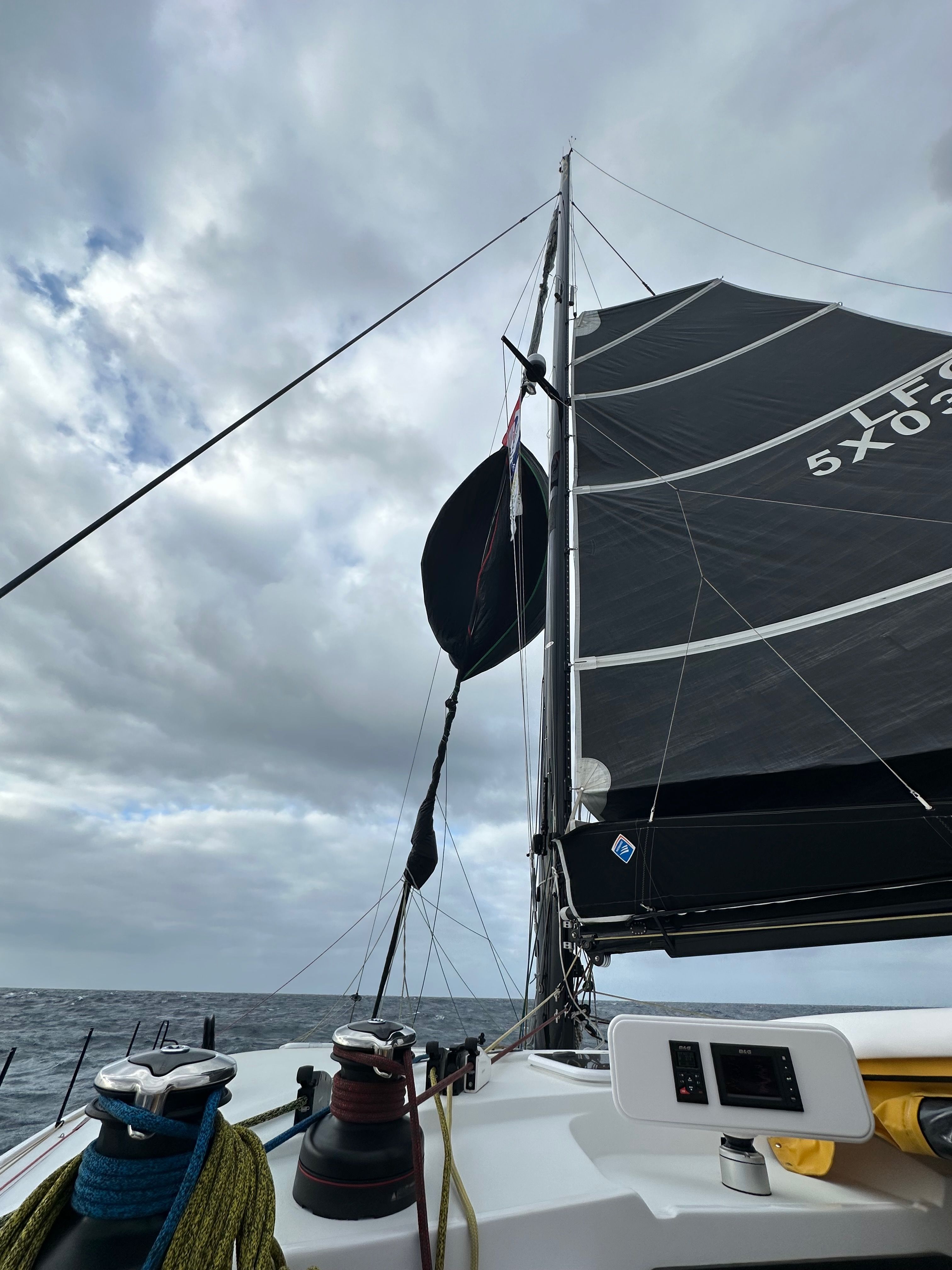
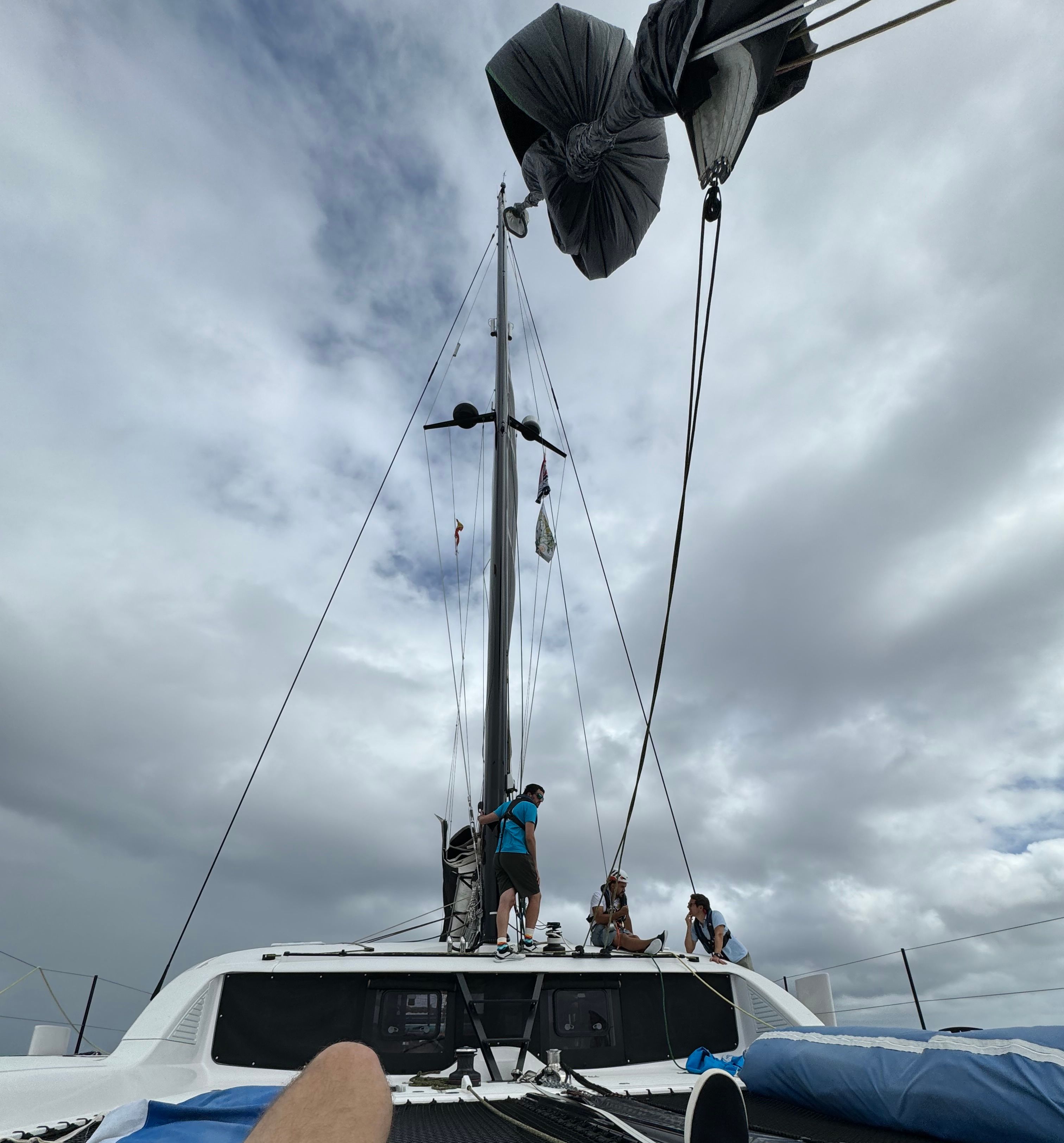
Now that you know the full story, let’s get technical. What happened was that the jammers (Spinlock ZS carbon) completely failed us. We had the spinnaker guys on these jammers and, when they failed, the foot of the sail moved forward, further forward than the head. We then lost control of the sail in those confused seas, and that’s when the wraps happened.
When the spinnaker wrapped itself around the forestay, things got tricky.
There were multiple things to carefully consider:
- The standing rigging
- The spinnaker
- The crew
As explained before (and can be seen in the pictures and video footage), the head and tack of the sail were the parts that wrapped around the forestay. The middle part did not wrap, and thus created a bubble/balloon that still acted as a sail, thus exerting a saccadic pressure on the forestay. We knew the forestay was not supposed to be stressed in this way, especially in confused seas and strong winds, and thus we immediately started planning for the worst case scenario: what if the forestay broke? And what if, after that, we dismasted?
We are familiar with probabilistic thinking, and thus tried turning the odds in our favour:
- We fixed the staysail and headsail halyards along the bowsprit axis, to act as jury-rigging;
- We briefly considered the option of turning around and going back to Las Palmas, but that would imply heavy headwinds. Downwind sailing, on the hand, relieves the pressure on the forestay.
Then there was the spinnaker. Our first reaction was to try and contain it, that is, to wrap it completely around the forestay and remove the bubble. But this was clearly a dangerous thing to do: the waves were now 3-4 meters high, and, to contain the sail, the person going up the mast would need to slide along the forestay. This was challenging for 2 reasons:
- The person going up the mast had to be kept from swinging violently towards the mast, so it was necessary to keep a line towards the front of the boat;
- The bubble did not just fill up and move forward. It was also dancing sideways, threatening to grab anything that would get near.
In the middle of this all, our top priority was to keep everyone unharmed. Thus, every option was discussed in order to minize risk… but it was clear we were not going to remove it from the equations completely. Our goal was to contain the damage/danger.
David went up the mast 3 times, wrapping as much as possible with tape and rope. However, completely securing the bubble proved impossible.
🧭 What’s our backup plan?#
Once David came down of the mast the third time, he was exhausted. His legs dangling as he came down, he couldn’t hold his weight once he landed on the roof of the boat. He had bruises as well. Worried, we tended to him, and re-assessed the situation. If we can’t solve the spinnaker problem, we need backup plans.
We visualized the worst case scenarios. As mentioned before, part 1 of the worst case scenario was losing the forestay, so we used 2 halyards as “temporary forestays”, fixed in place to work as backups.
Should part 2 of the worst case scenario occur (dismasting), we had enough diesel, but started looking for a port of refuge. Mauritania was our best shot, so we contacted a person on Navily who had been there before. We wanted to assess how feasible this plan was. We must thank Nigel who promply responded to our messages and explained that the port is full of friendly people, but the administrative procedure is a bit slow as they are not used to receive sailing yatchs.
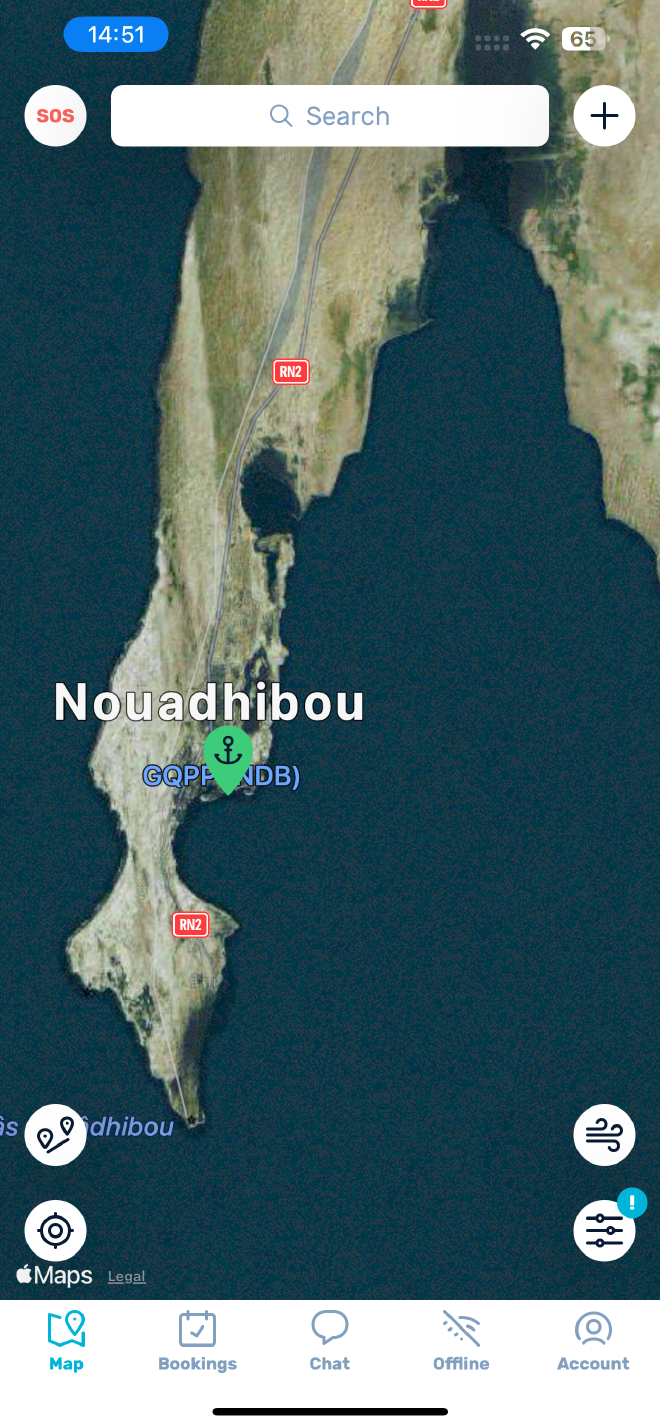
Fortunately, we managed to get to Mindelo without having any additional accidents. It was a relief…
🌊 18.4 knots surfing waves#
The next days were bumpy. We eventually put a third reef in the main because the winds were very strong and we wanted to reduce the strain on our autopilot. Despite having so little main sail area and no headsail (only that blasted spinnaker bubble), we still surfed waves at a maximum of 18.4 knots boat speed!
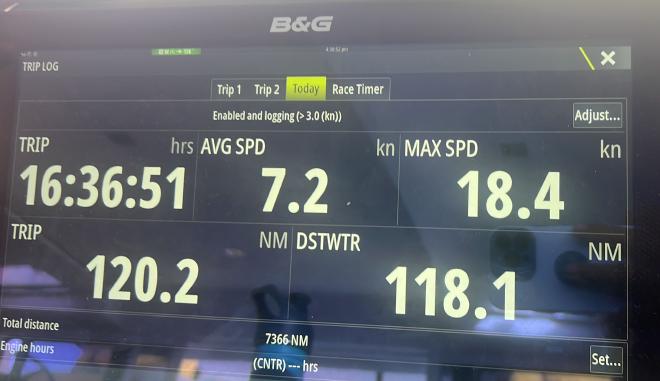
💖 Incredible support from the ARC+ Fleet & Organization#
Despite the challenges, we felt incredibly supported. We were messaging the fleet updates on our situation via the ARC+ WhatsApp channel, and received multiple messages of support. We felt the ARC+ team and ARC+ boats were keeping an eye on us. We also activated our Nuvem Mágica Guardians.
Cnce we arrived in Mindelo, we were greeted by so many friends, who came to cheer us on the dock ❤️
Kudos to the ARC+ Org team, who got us the easiest spot to dock on the pontoon and a good spot to then handle the sail once we arrived!
🔪 Aftermath#
Exactly. Even with the boat now docked, our issue with the spinnaker was still not solved. We needed to take it down. David went up the mast again but, even in safe harbour, it was a dangerous endeavour. Saving the sail seemed ultimately impossible. And so, we parted with the spinnaker forever. We sliced it up and took it down, cut out the clues, took the rest to town and donated it.
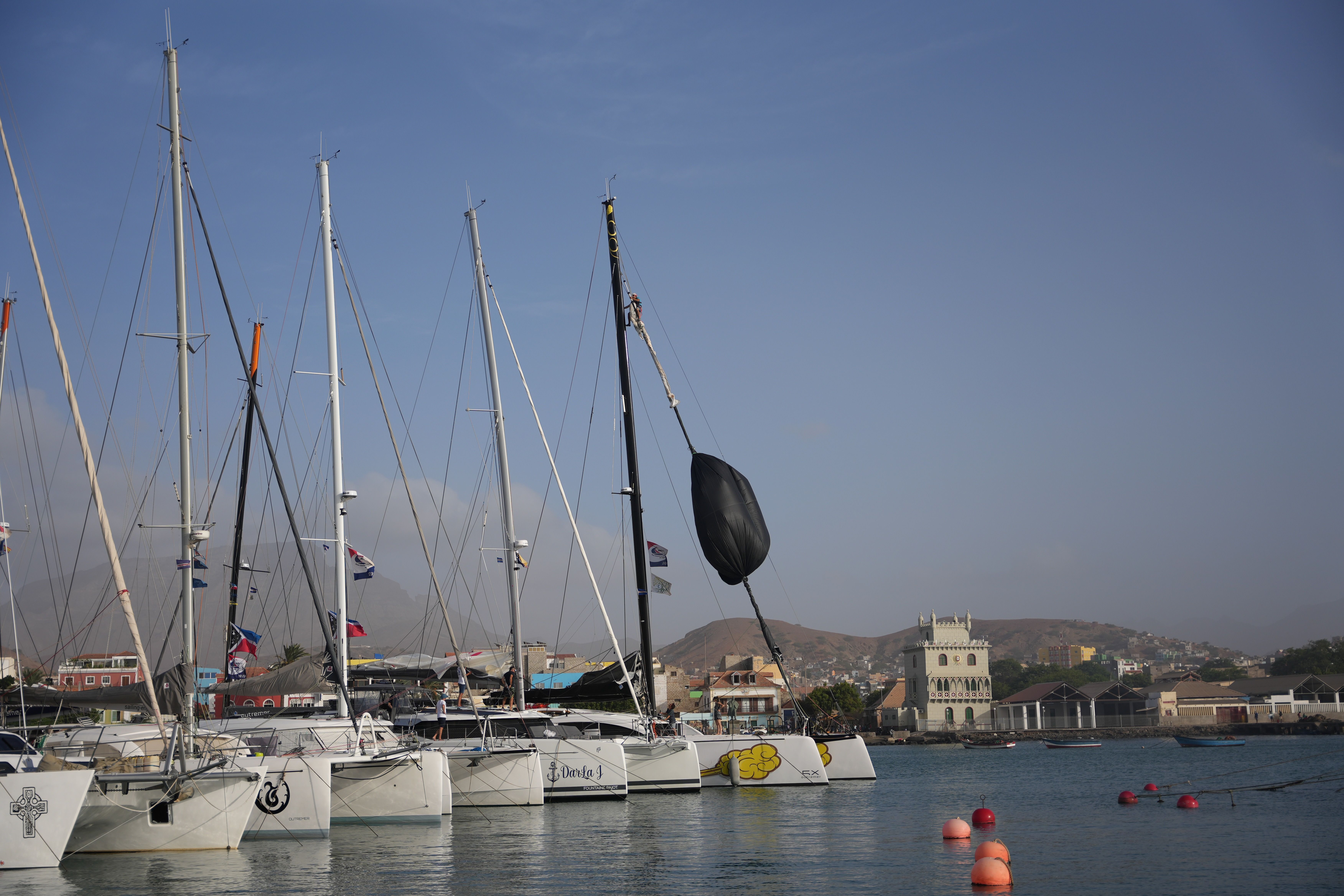
⛵️ What about the rest of the ARC+ 2023 fleet#
We were not the only ones in trouble. Several boats faced issues. From breaking goosenecks and shredded sails, to snapped lashings and dismantled halyards, the ride was sporty and the problems many. We will keep details of what other boats went through to a minimumt to respect their right to share their stories themselves. Nevertheless, to give you an idea, someone described this leg as “carnage” in one of the group chats.
🎉 Reprogramming experiences#
We then proceeded to throw a party (more details on that legendary party in our next post) and have all our friends sign the clues. Reprogramming associations, you might say 😉
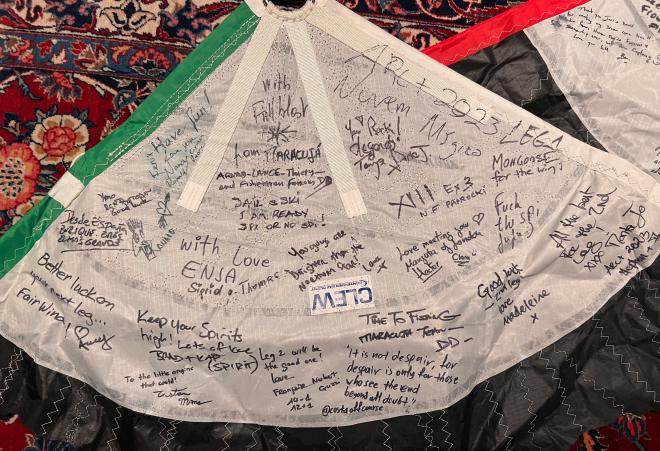
🧑🔧 Fixing the root of the problem#
Even after taking the sail down, we still have to fix the underlying issue that led to this situation: the Spinlock ZS carbon jammers.
We did countless tests: we couldn’t believe how the 5 Spinlock ZS Carbon jammers we have onboard all failed in the same way. We ran experiments by cleaning them following the owner’s manual and using Spinlock official product. Then we tried different rope types (polyester, technora, aramid) and sizes (10mm, 12mm, 14mm)… and every single rope slipped through.
We knew that 2 of them did not work well from the first week of having the cat, but we never thought that the remaining ones would fail so spectacularly. What ensued were long months of discussions with Outremer, who finally helped us solve the problem by simply taking these units out and replacing them with sturdier Antal Double V Grip jammers. We were able to get the replacement done in Martinique in February 2024 🎊, while we visited Grand Large Yatching’s new service center in Le Marin. Big thank you to the entire team that worked on figuring out a solution for our root problem ❤️
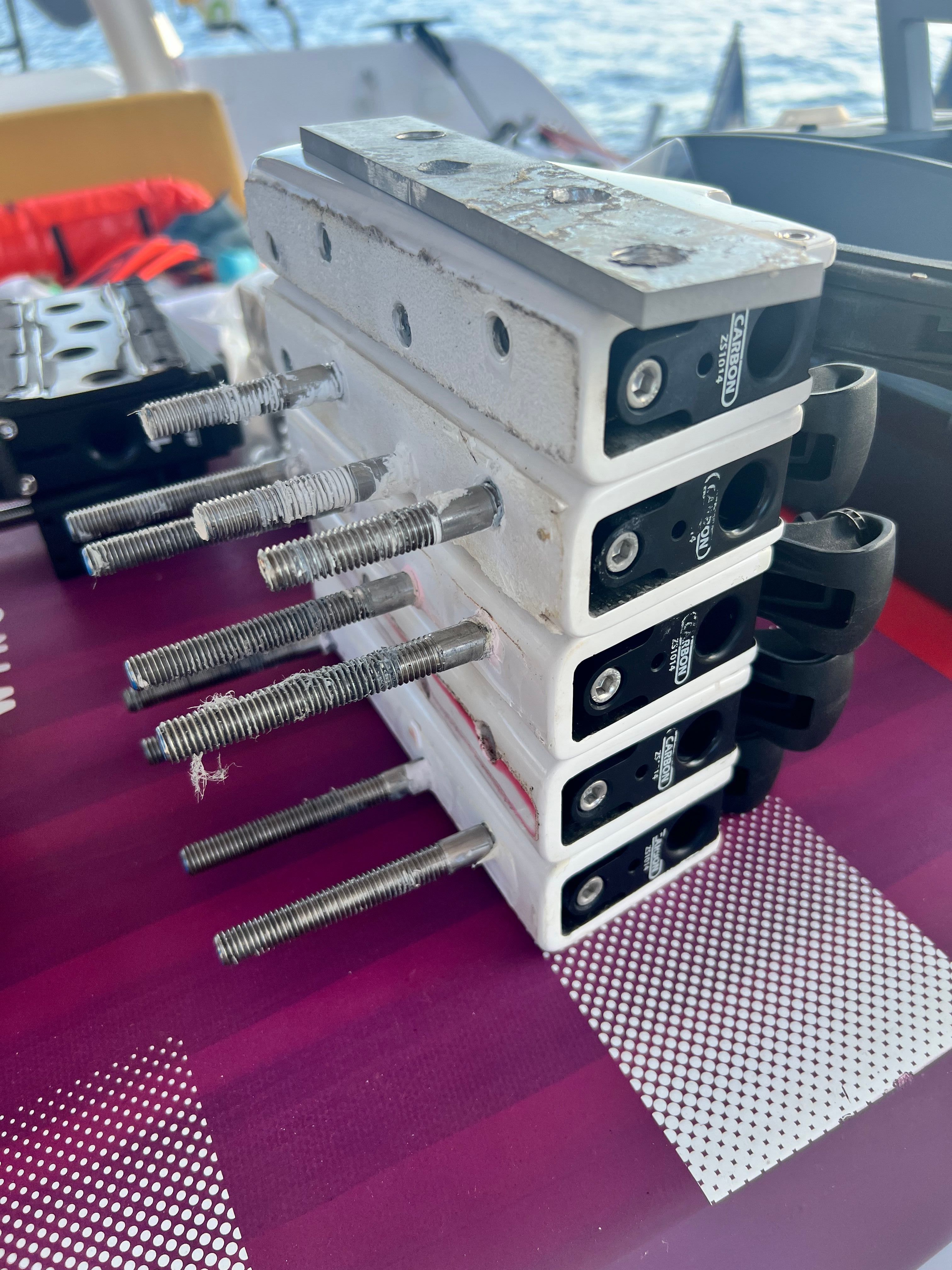
✨ Additional highlights#
Despite these challenges, there were many highlights in the trip!
🐟 Flying fish everywhere!#
Flying fish were a regular attraction. In the beginning of the trip, we tried saving them, but there were just too many of them. They landed in the most awkward places, including one that found its demise with its head stuck between the deck and a pulley, tail in the air, and others that assaulted some of our crew members!
We had so many on board that:
- We implemented morning checks and cleanups
- Inês wrote a poem for them (to be revealed in a later post 😉)
- We found flying fish in our main sail when we hoisted it again, as we left Mindelo to Grenada!
👩🏼🍳 Galley Chefs!#
Our crew and captains did super well on the galley front. We enjoyed some delicious and hearty meals throughout the trip.
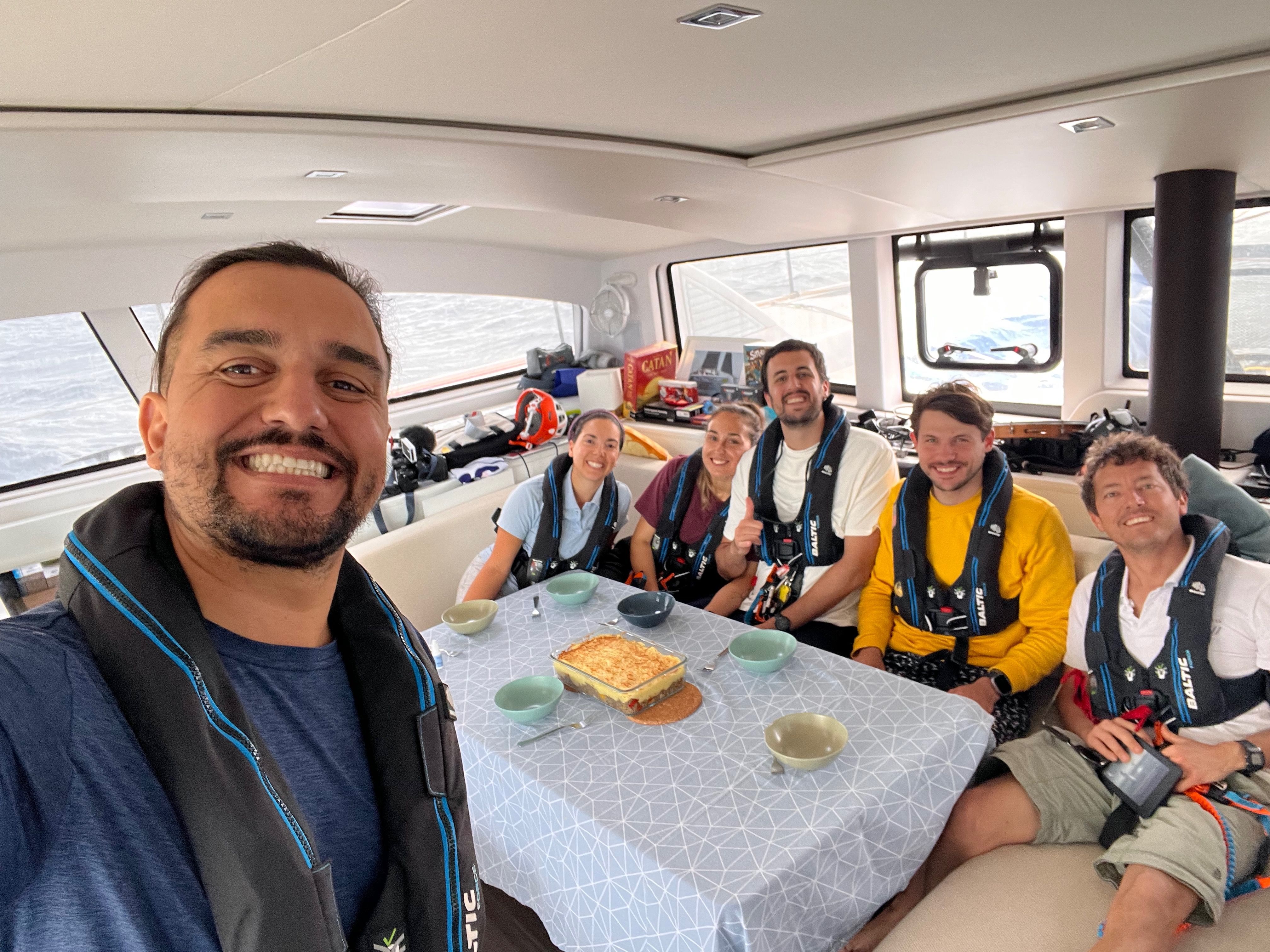
🧑🏫 Retrospective#
Crossing the ocean is already a profund experience. Crossing the ocean with a problem that puts you and your crew at risk can mean trauma and/or transformation.
There were multiple learning points coming out of this leg. We tend to lean on the side of being prepared, however, in this leg, we learned that we can do better.
For instance:
High-performance gear doesn’t mean failproof. As we document above, Spinlock ZS carbon jammers cannot be trusted. We had 5 of these onboard, we knew that 2 of them did not work well, but we never thought that the remaining 3 would end up failing as well. This is not a production problem, it is a product problem. We’ve met other owners of performance catamarans that have them and time and time again we hear that they don’t trust these jammers (to the point that they have had to come up with other clever ways of going around this problem).
In sailing, you might want to play it like a video game: have levels of difficulty. Don’t start out with something new in a super challenging environment. For example and if possible, try new sails or new equipment out on day sails or situations with lower stakes.
Should have we cut it to start with?
- A person that became a source of wisdom in the ARC+ made an interesting and at the same time provocative statement (we know it came 100% with good heart ❤️). The statement was: “The reason you had the problem throughout the rest of the trip, is because you wanted to save the spinnacker”. When we heard this, we had a bit of a shock moment. Had we been careless to our crew’s safety in favour of a sail? That didn’t sound like us at all. Was there a moment to cut the sail? We tried to build a spear to punch a hole through it on the 3rd day, to no avail.
- In retrospect, had we known the amount of stress we would be facing, we would have tried cutting the spinnacker right away (or at least considered it more seriously).
- Nevertheless, would that have been the right plan? What if we cut it and it fell under the boat, blocking the rudders and propellers like what happened to the folks crossing in Moonshot? How would we then take it out with the confused sea state we faced?
- At this stage, these are all just thought experiments though. What is done is done and, fortunately, no one got hurt and we were able to continue to sail Nuvem Mágica across the ocean.
- This story will now be one of those hard-earned lessons in our portfolio that will help us become better sailors.
💚 Things that went well#
In hindsight, a real adventure only becomes a true adventure once there is a challenge. Despite the nerve-wrecking event, we got to test our protocols and skills to the core and, with it, there were multiple things that went well:
- David and Inês are co-captains and this proved to be a very useful model in this trying trip: when one of us was exhausted, the other could take the lead. Seeing David up the mast was the lowest point for Inês, whilst the worry of dismasting was what took the heavier toll on David.
- The crew kept their morale high ❤️ and calm at all times. A big thank you to Margarida, Pedro, Arnau & Vuk for keeping it together even though it was a new situation for everyone. Your support really made a difference for us ❤️.
- When the spinnaker wrapped itself tightly, we took some time to think about what to do next, instead of rushing. It’s very easy for the dominoes to start falling and someone getting hurt. Fortunately, that did not happen.
See you soon 🔜,
Your Nuvem Mágica

